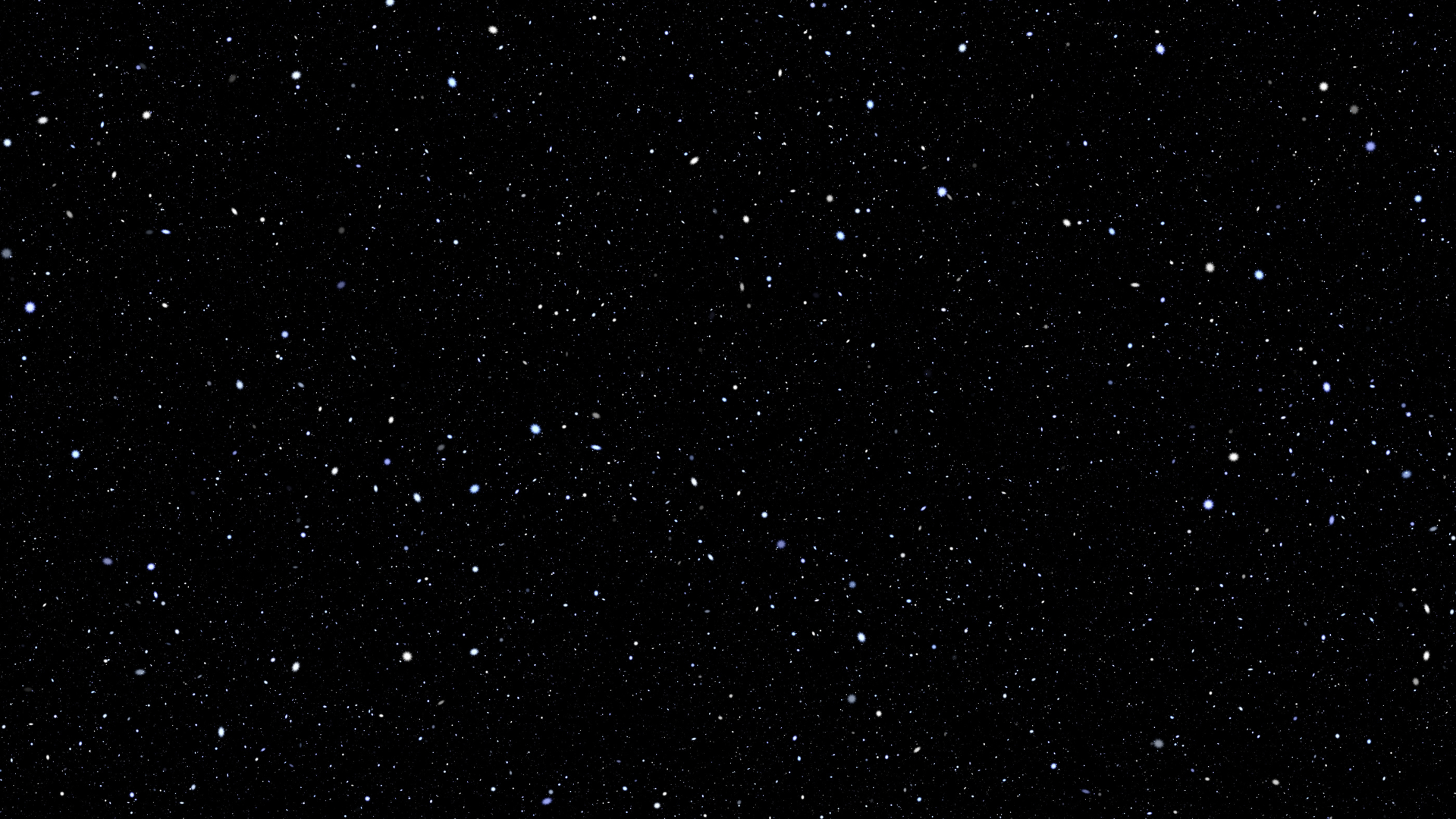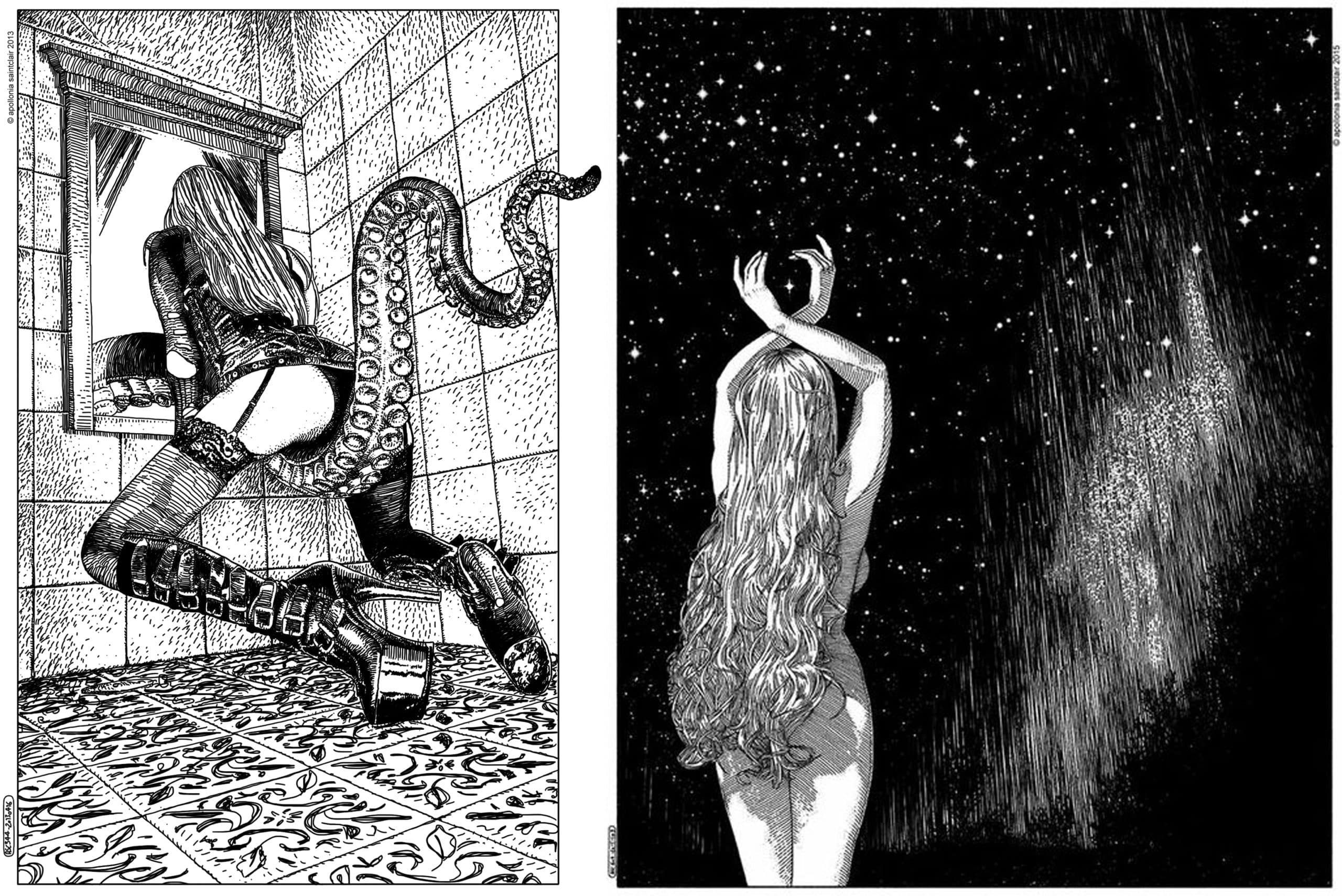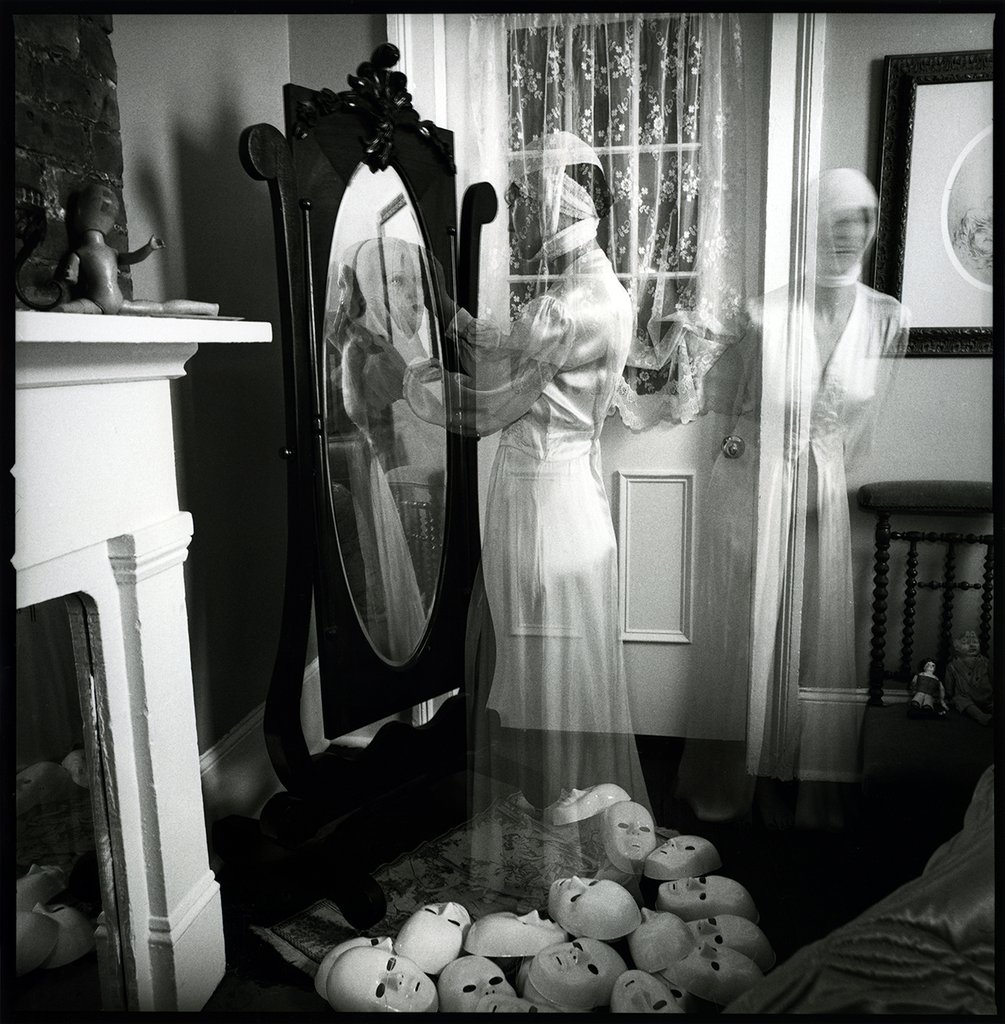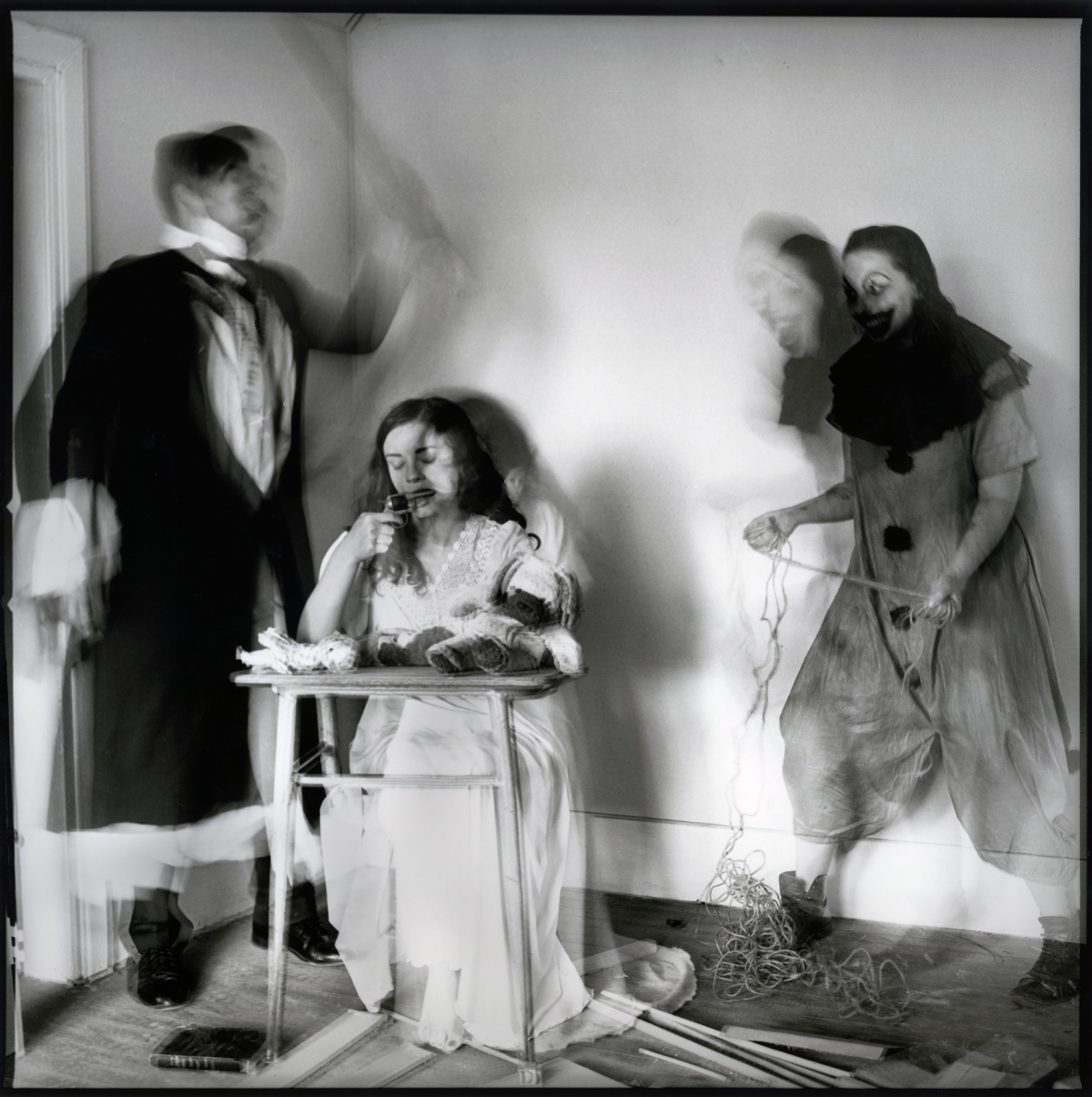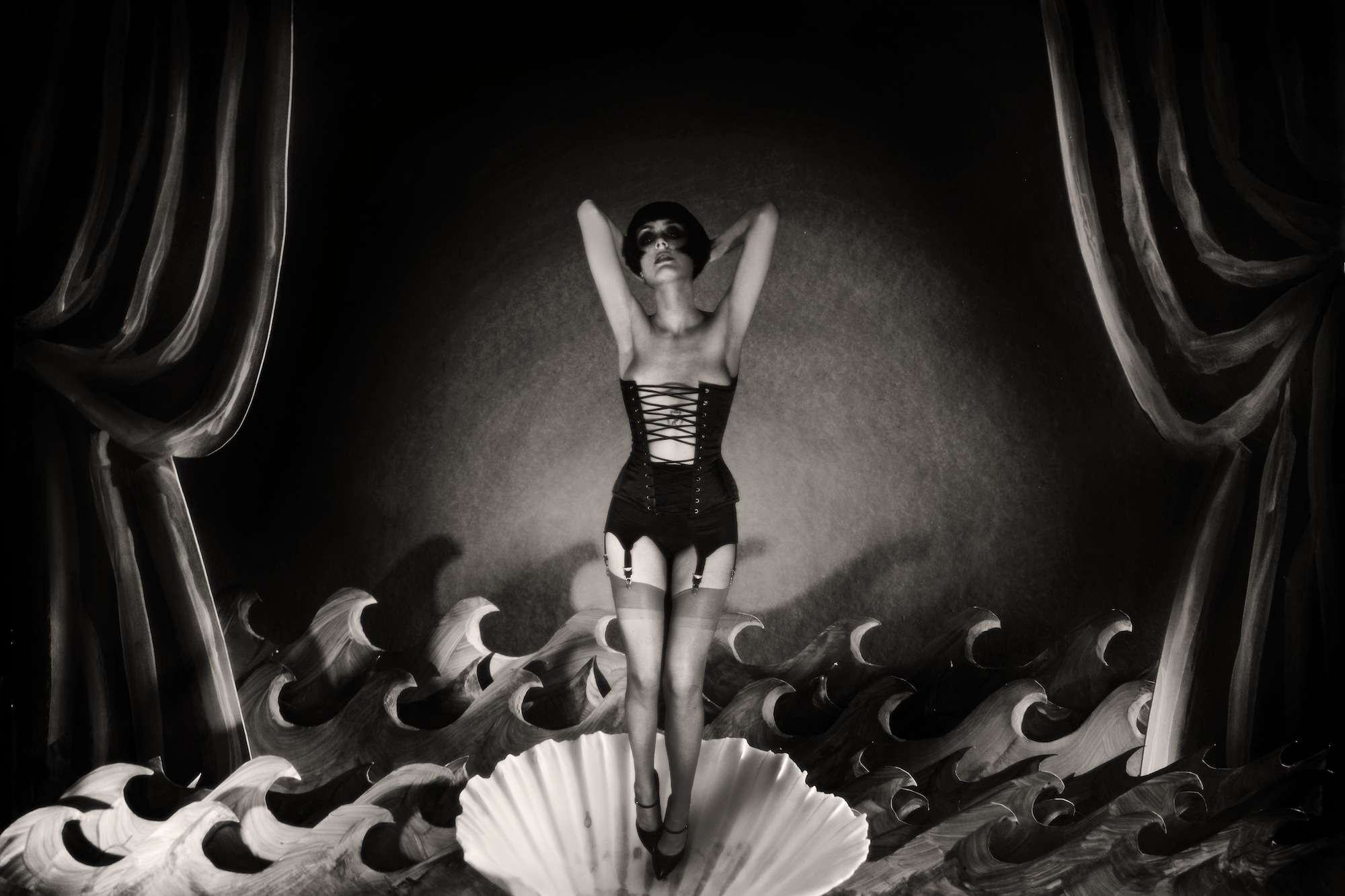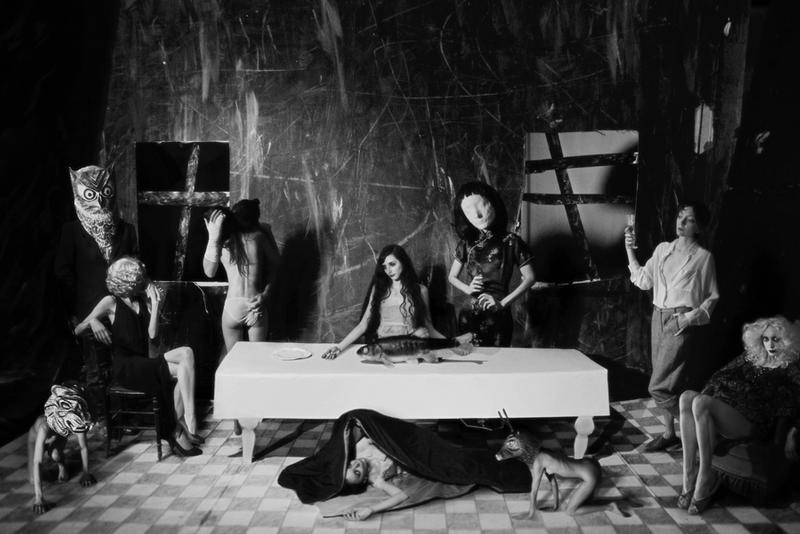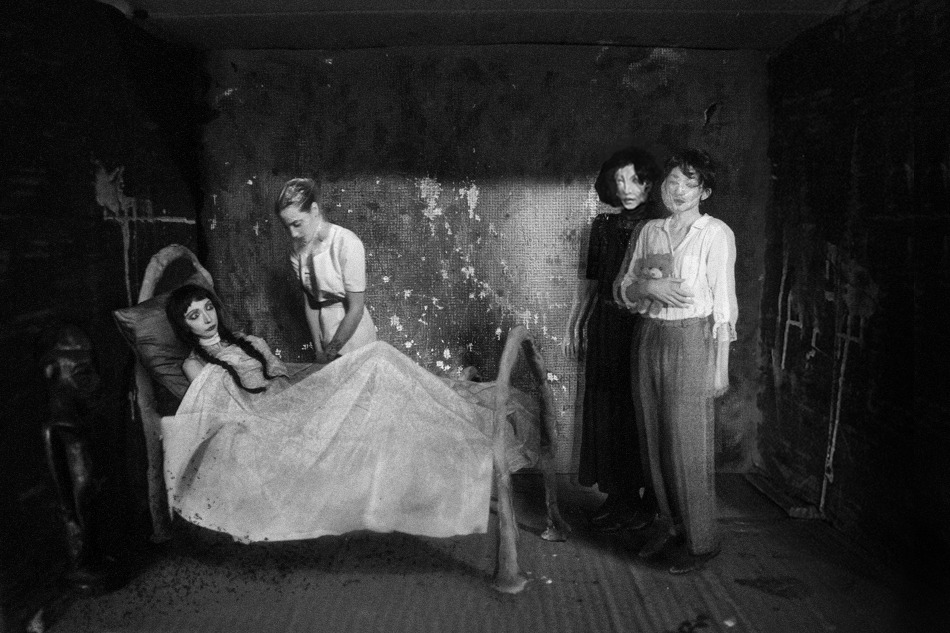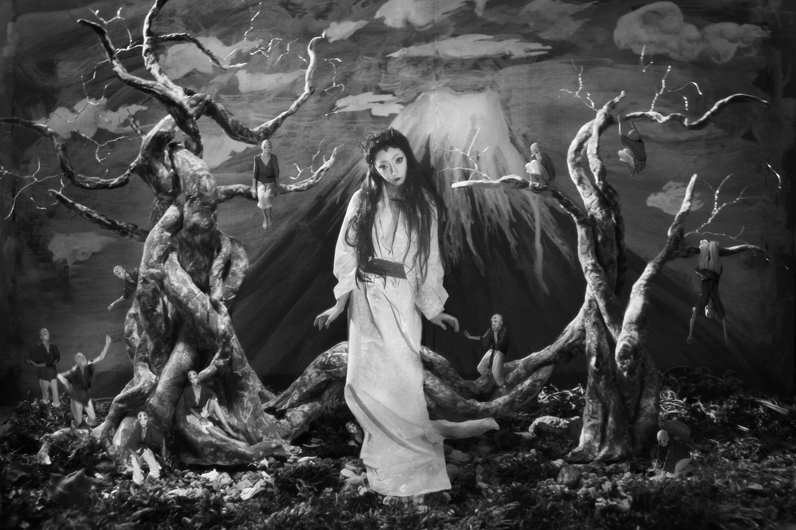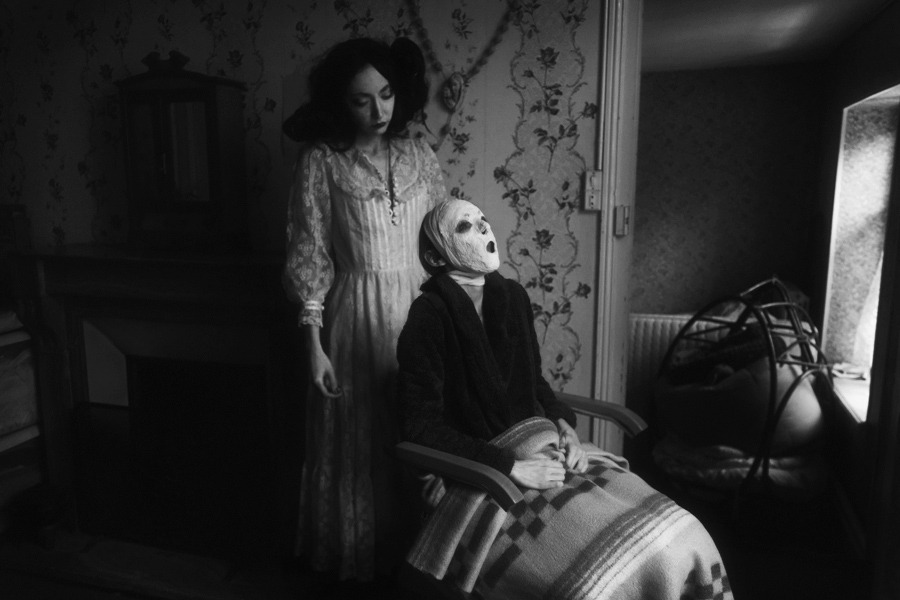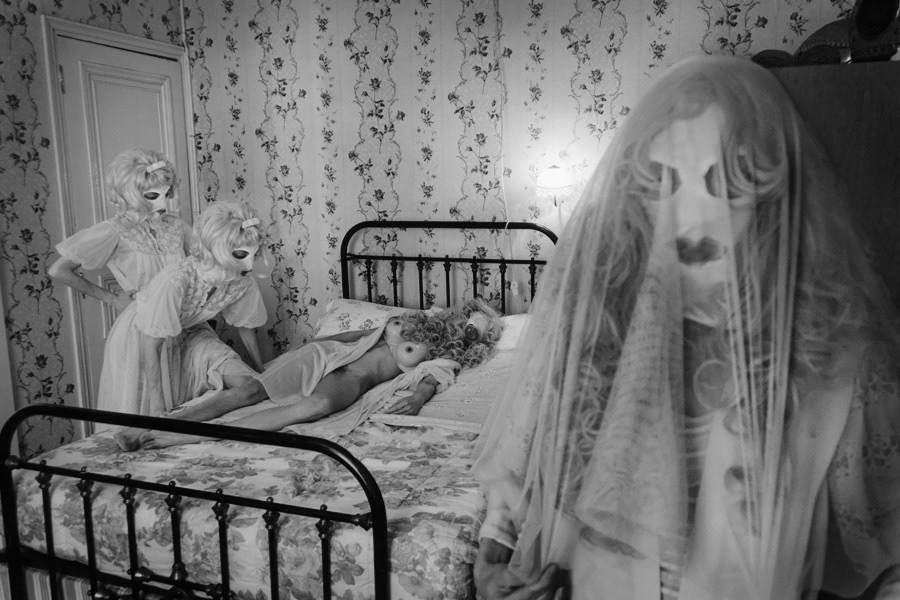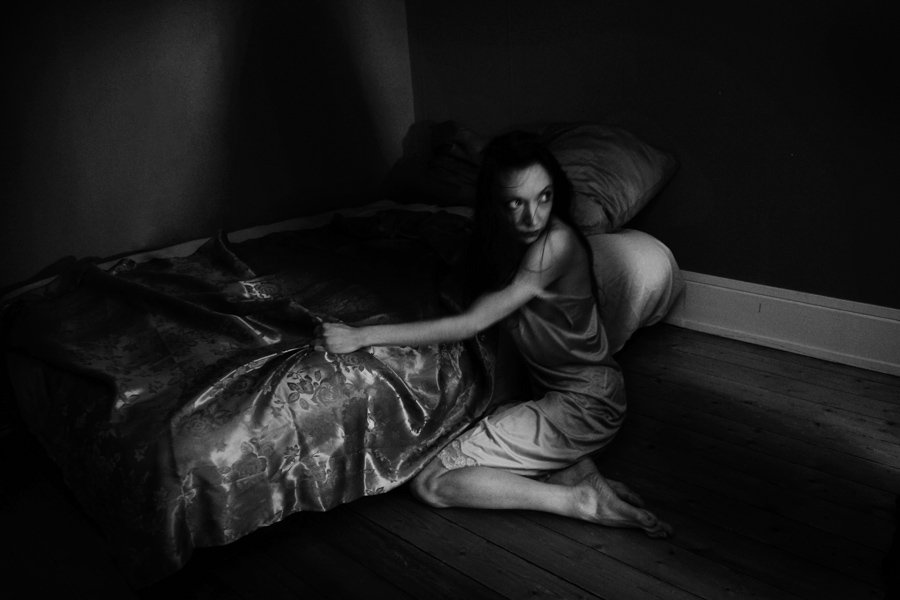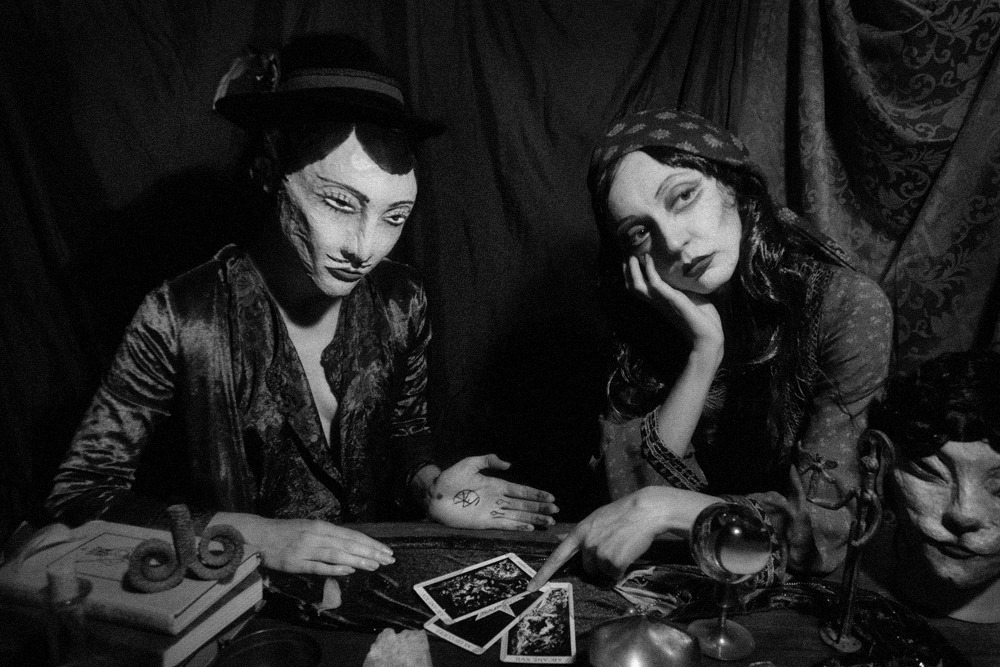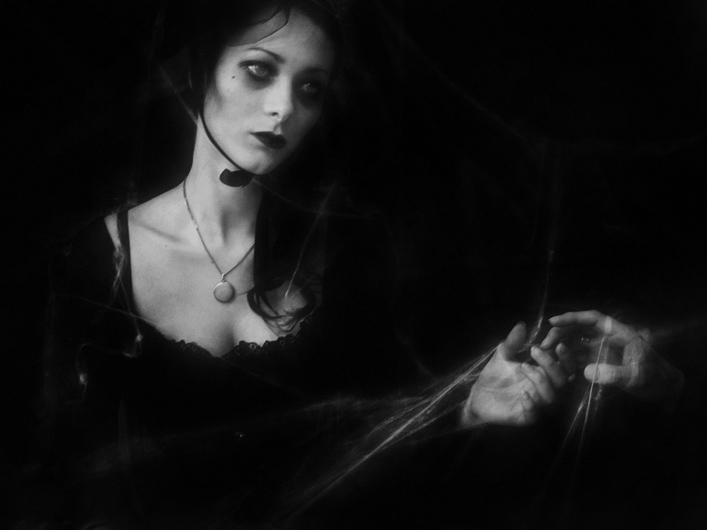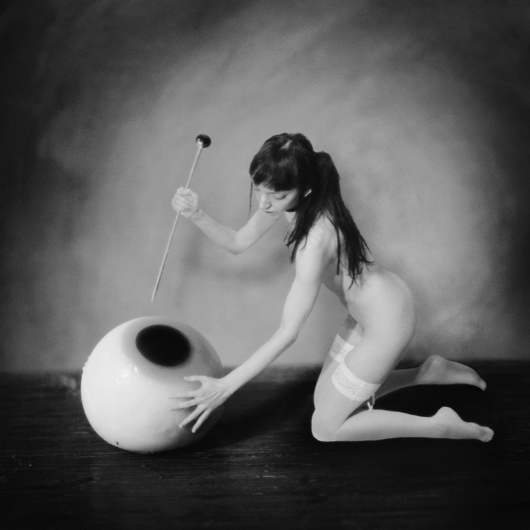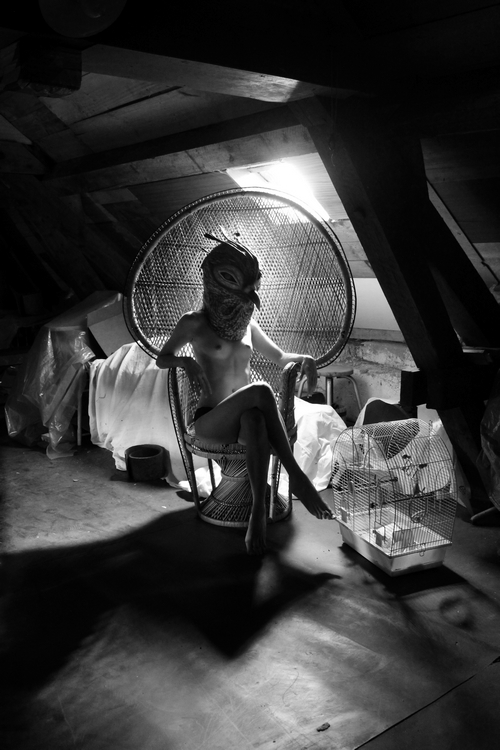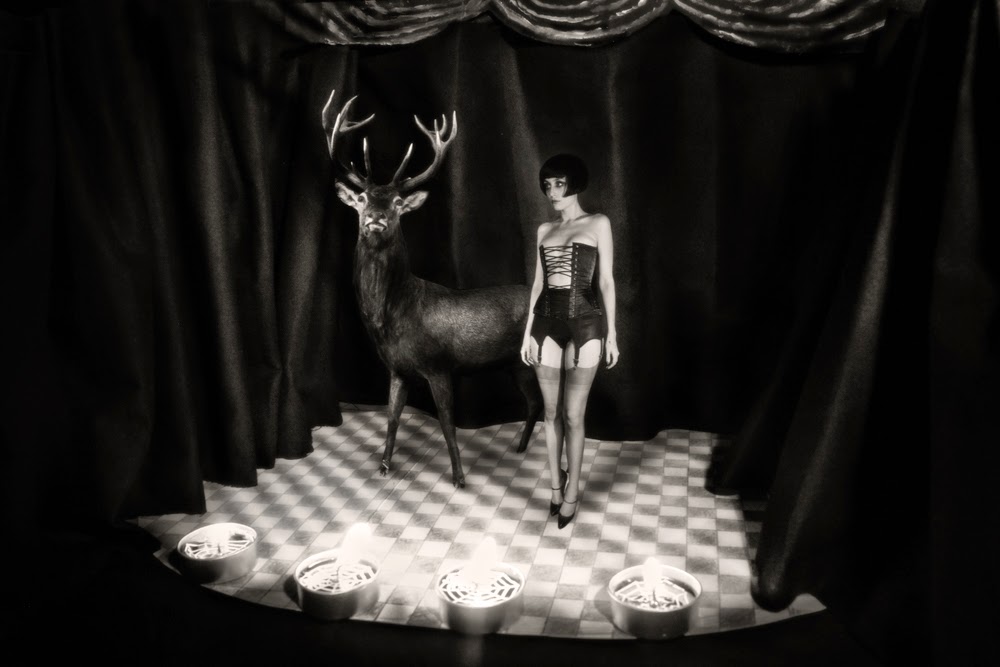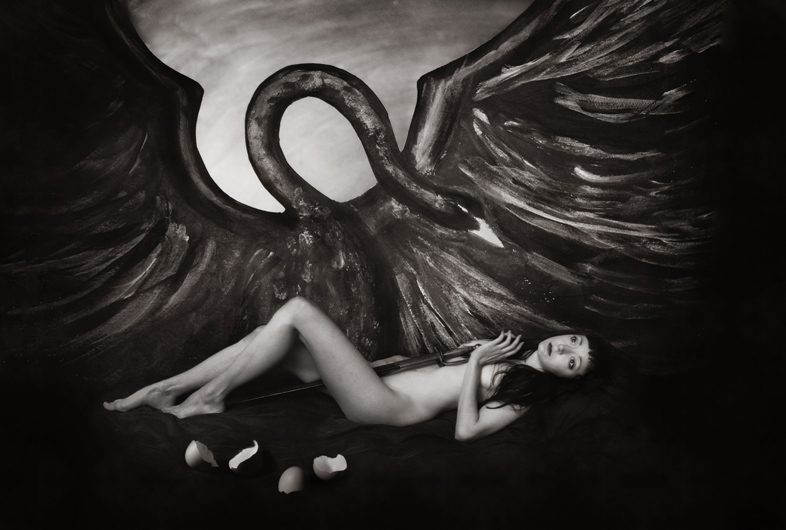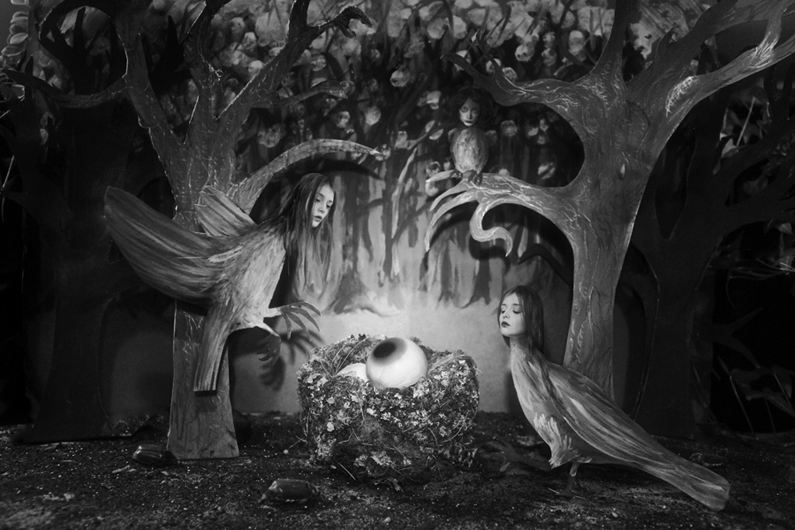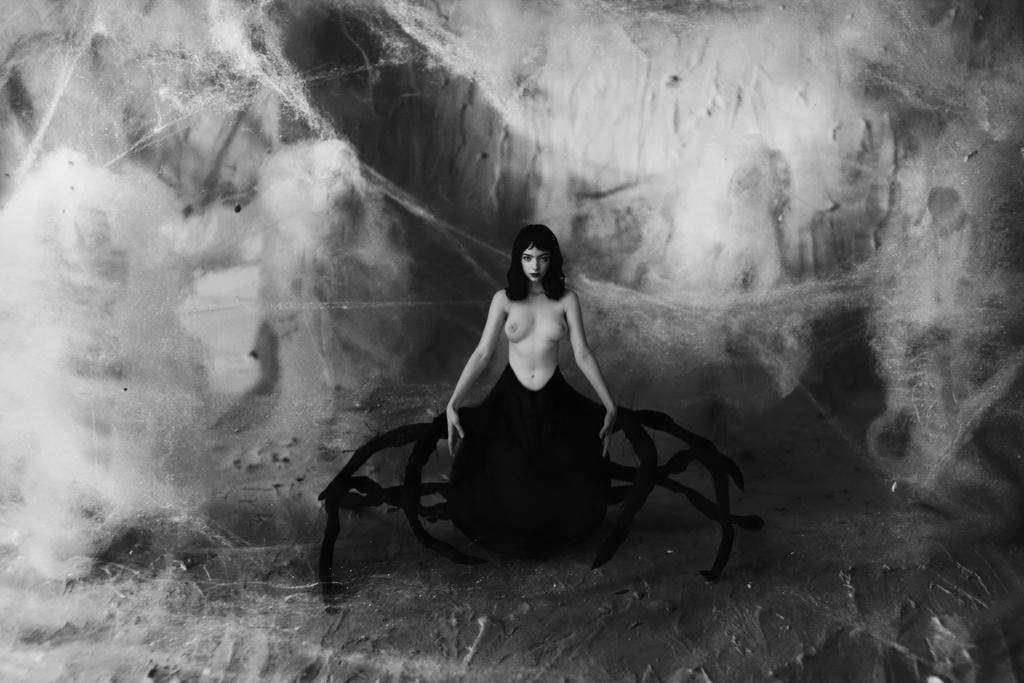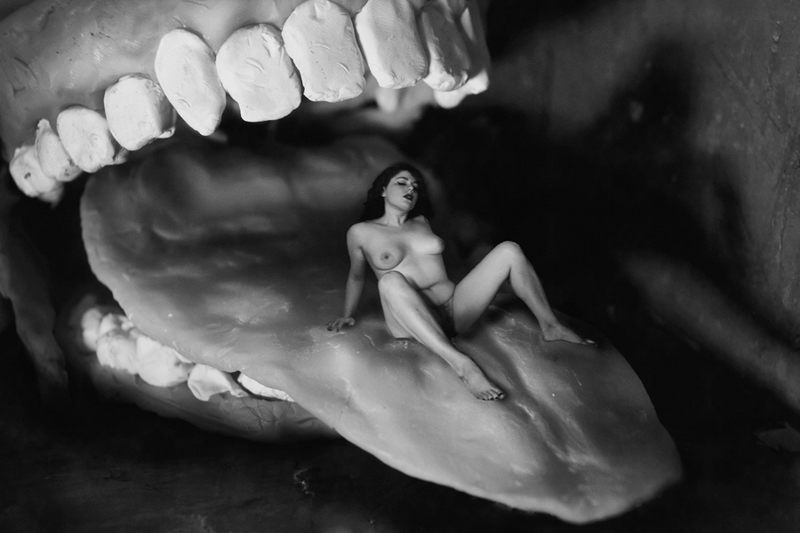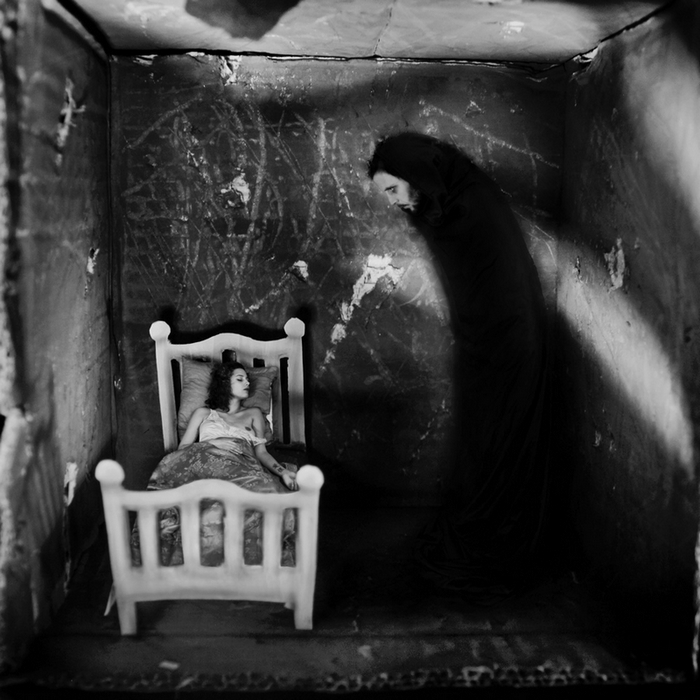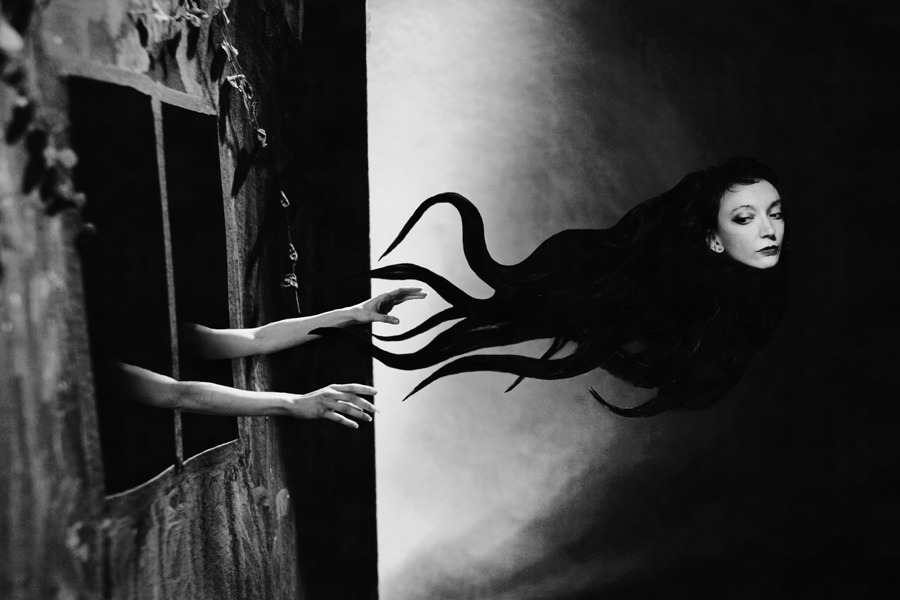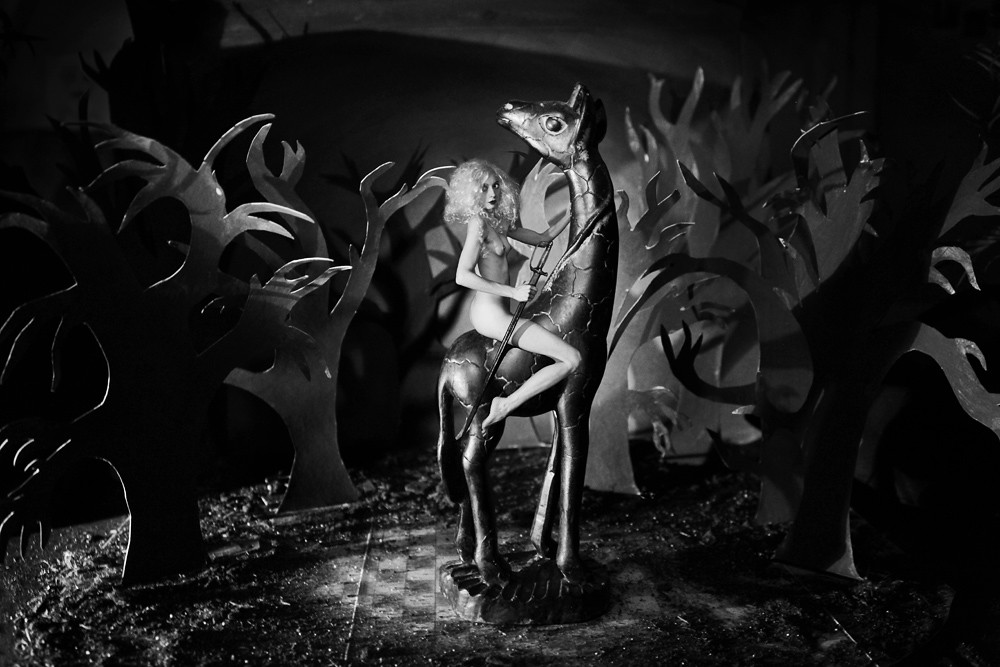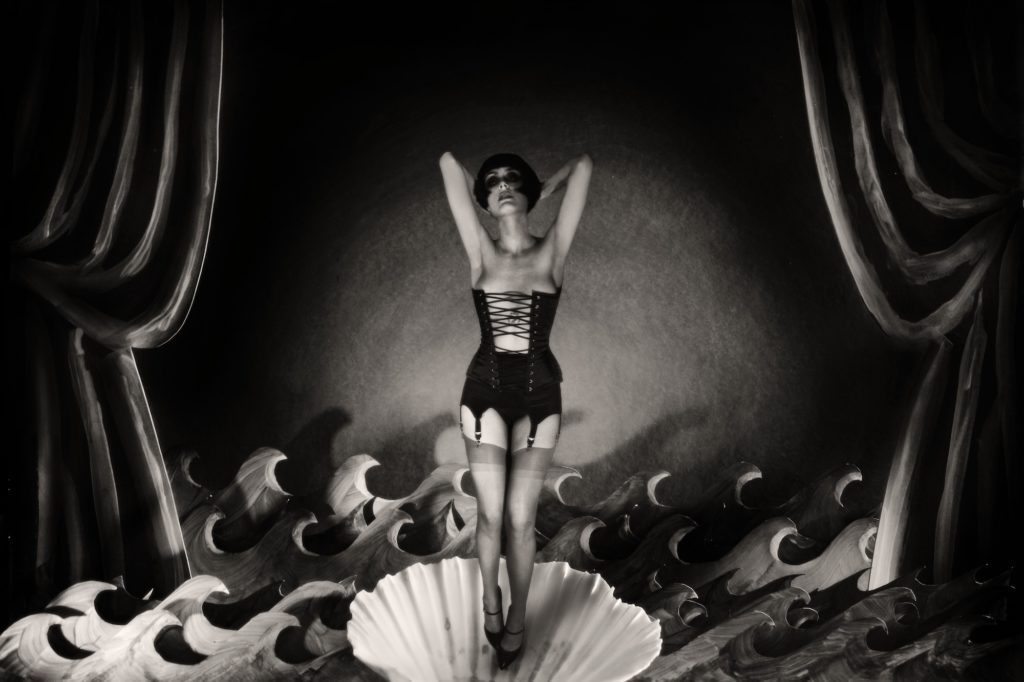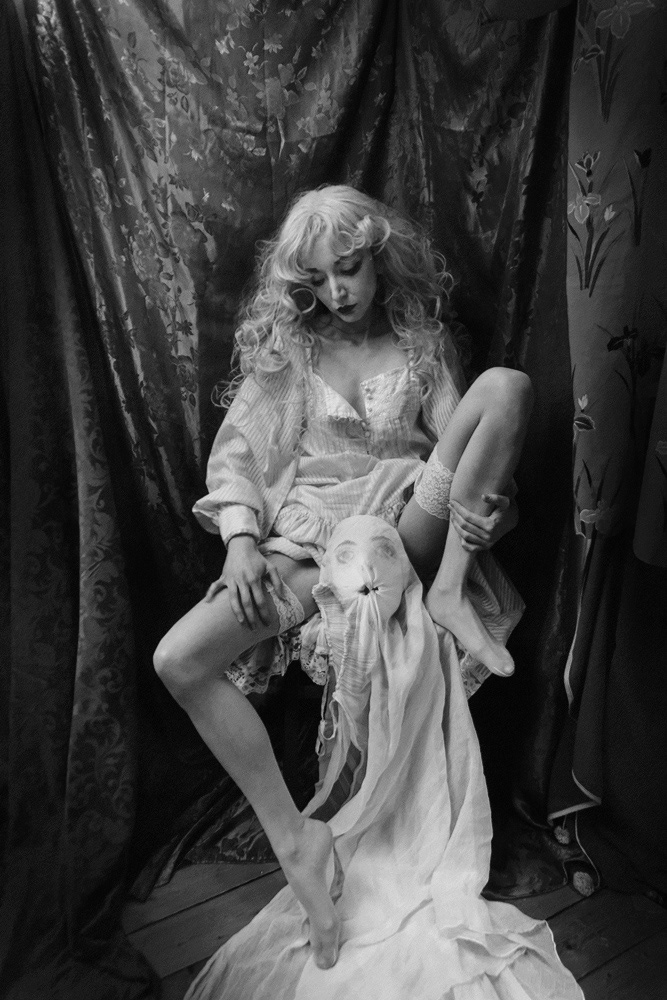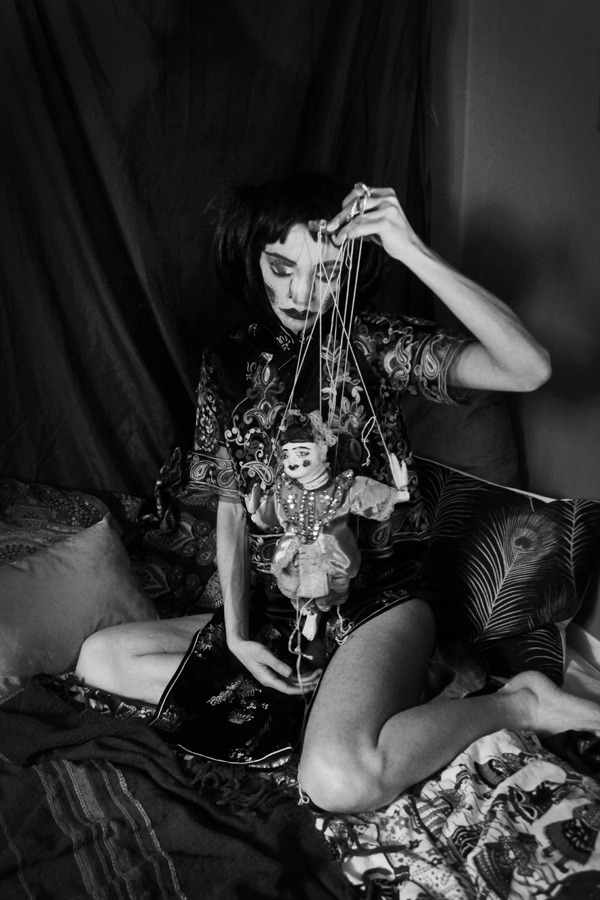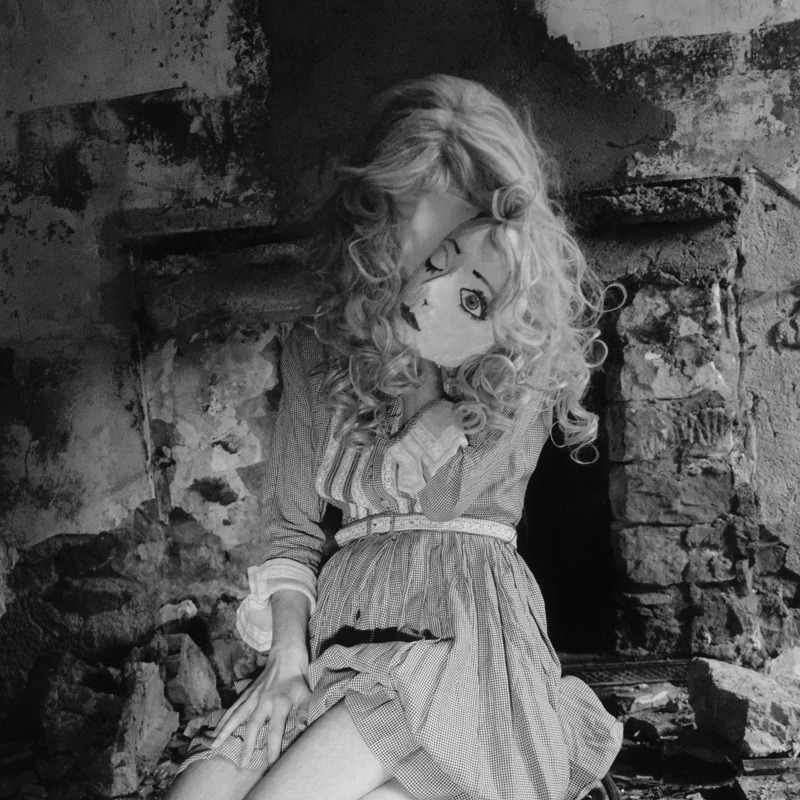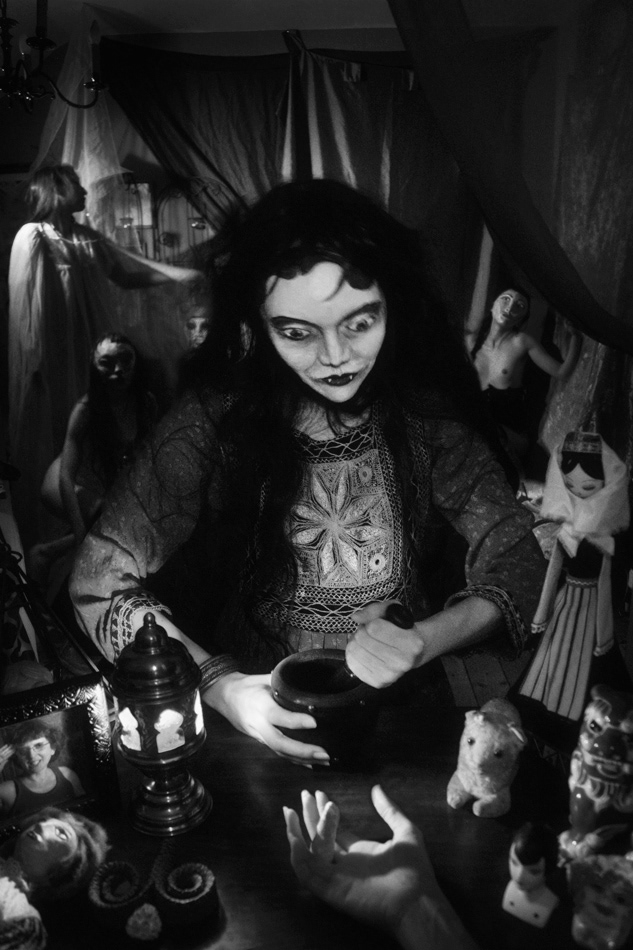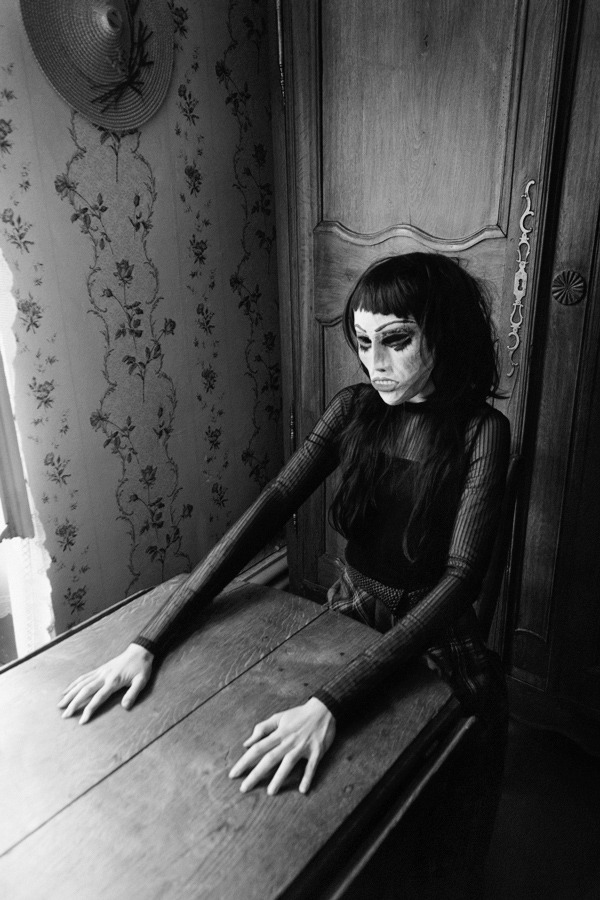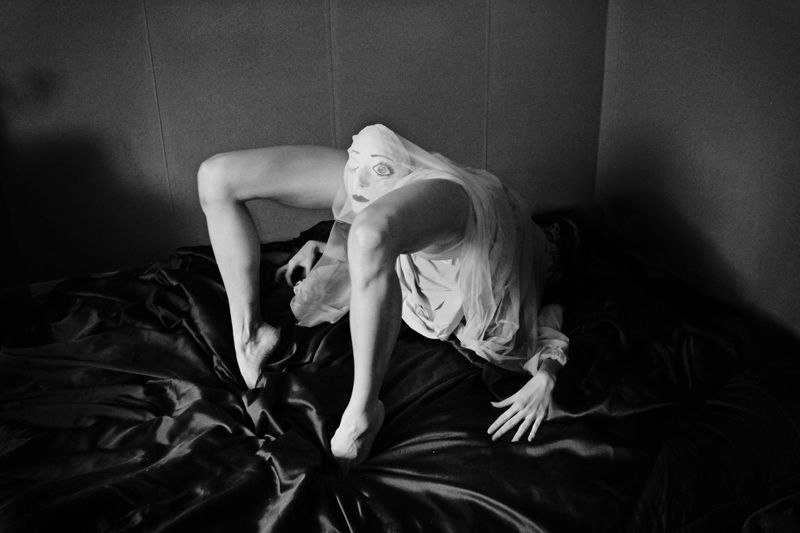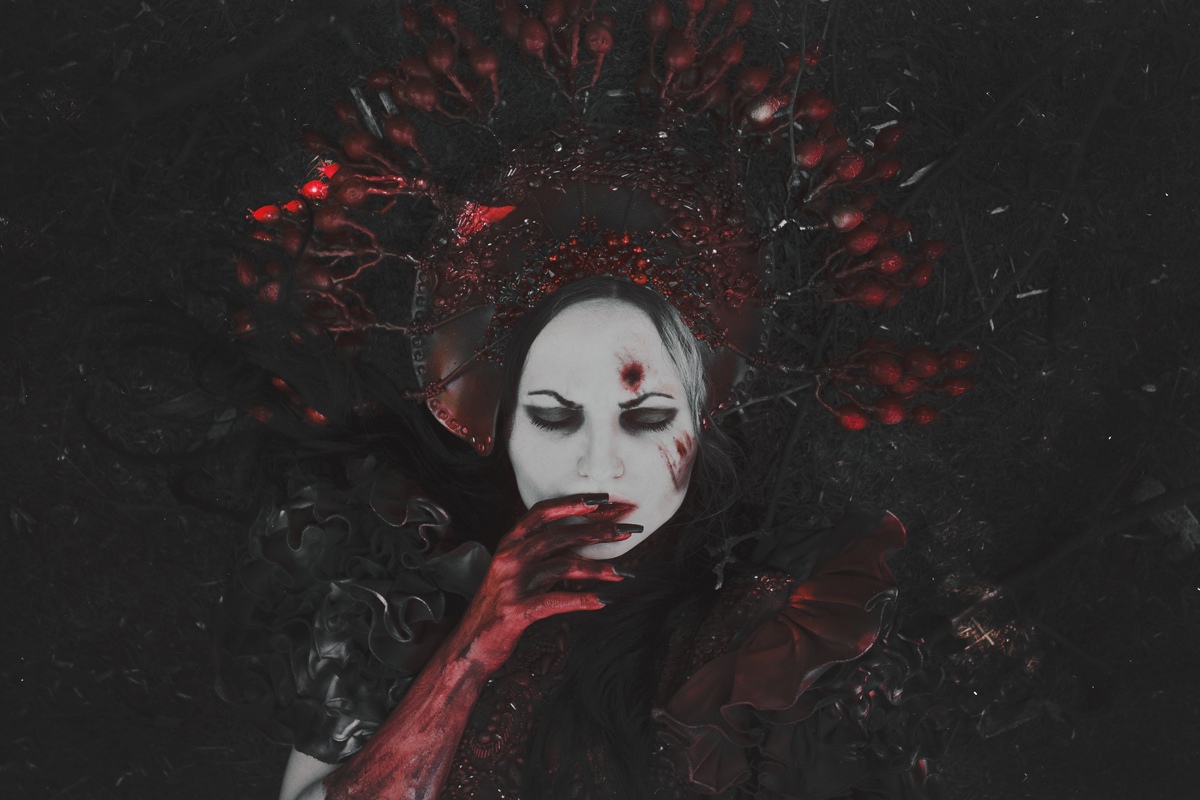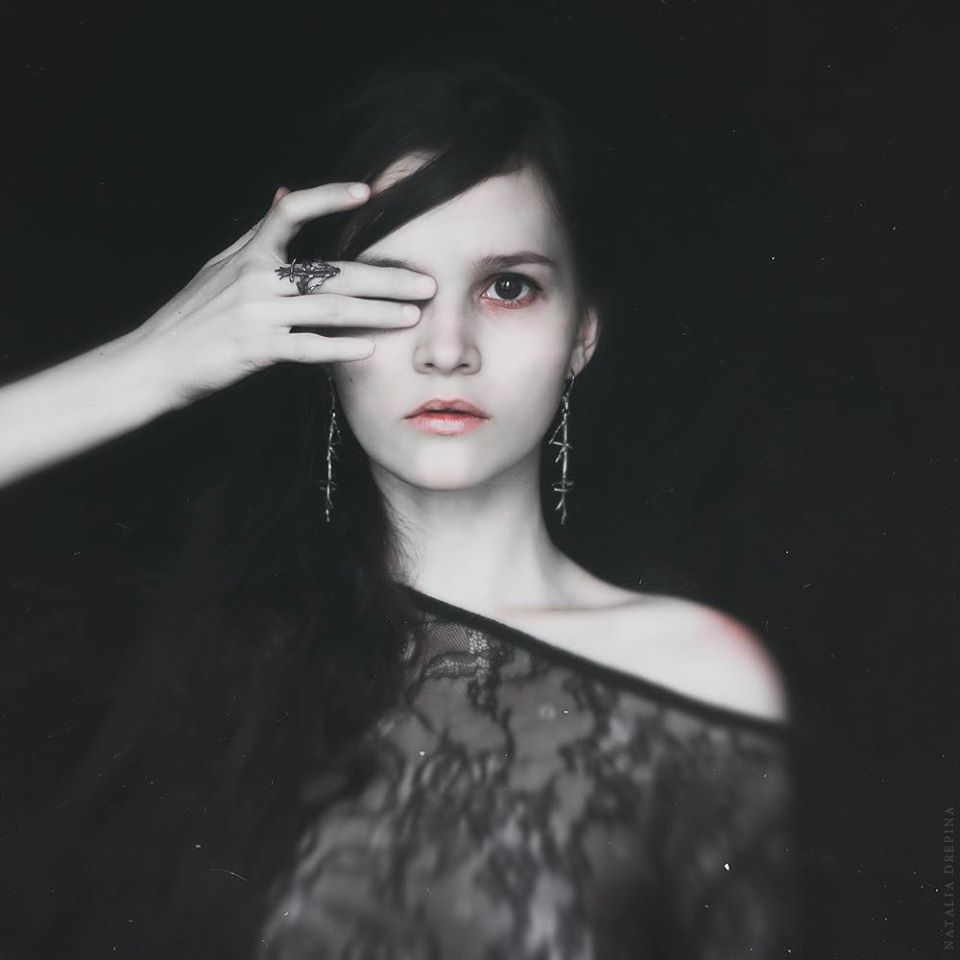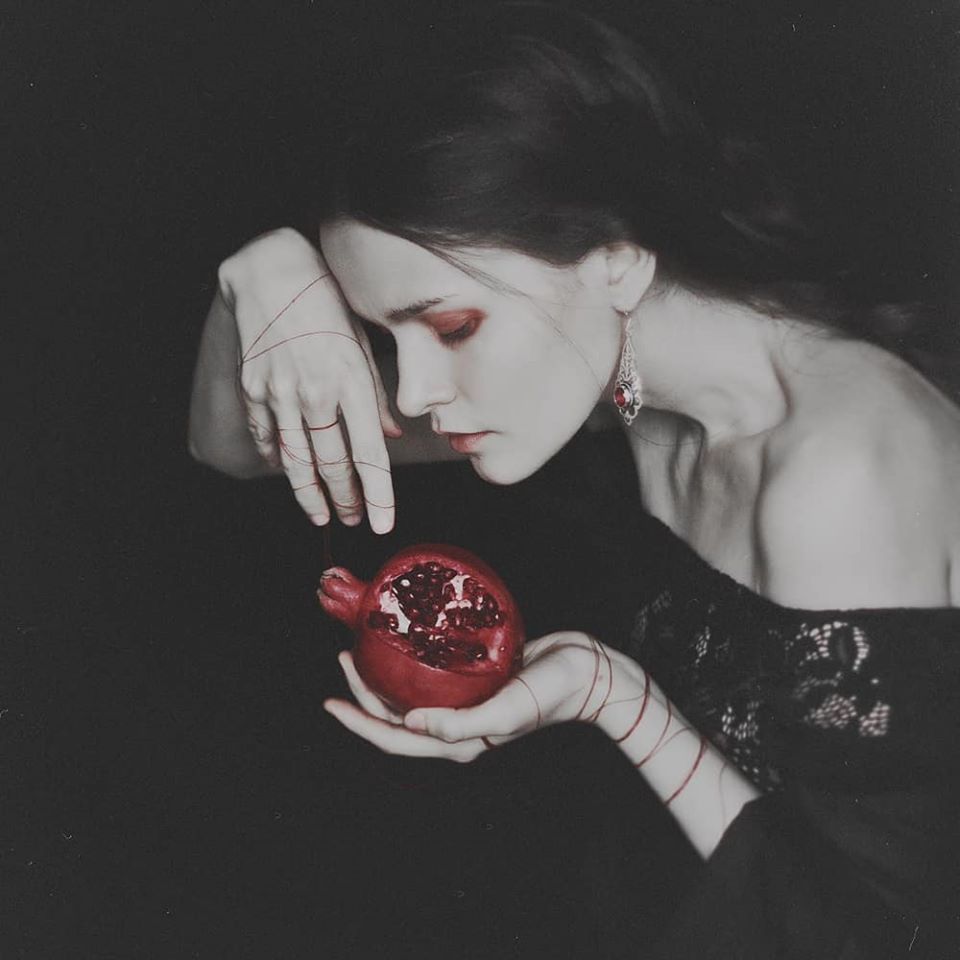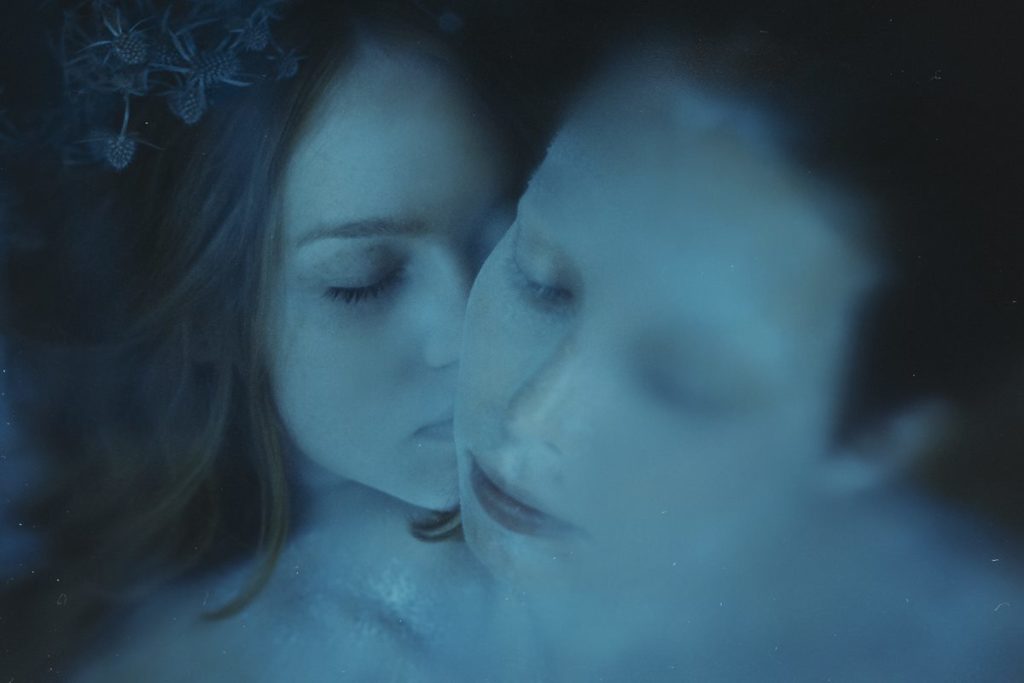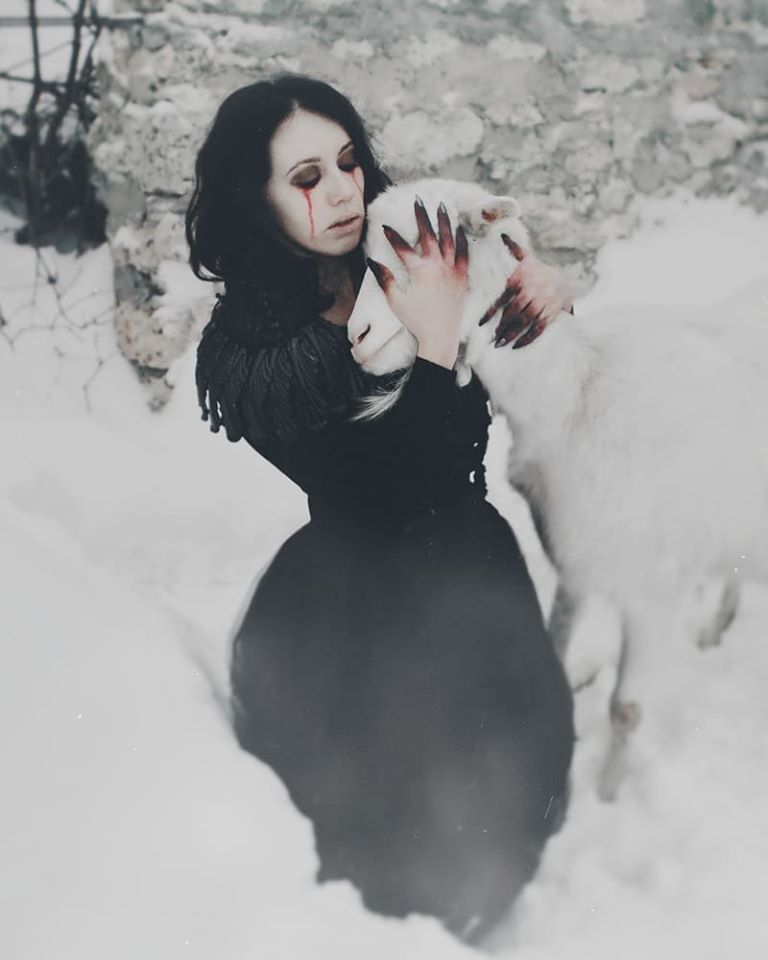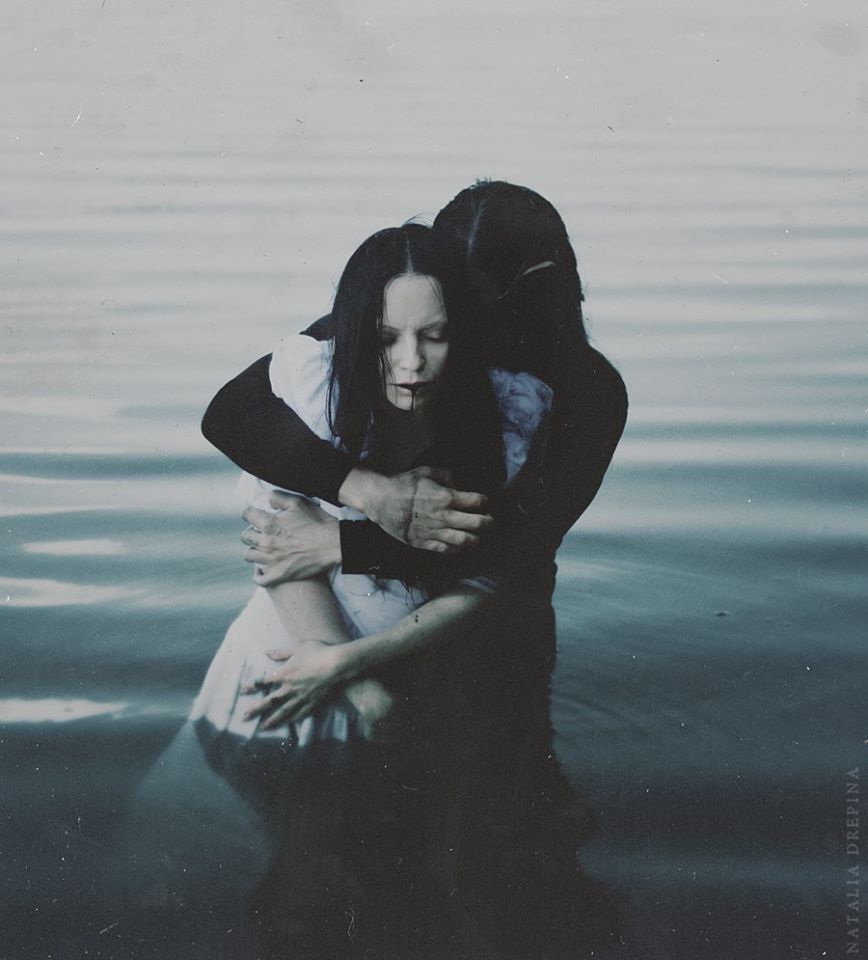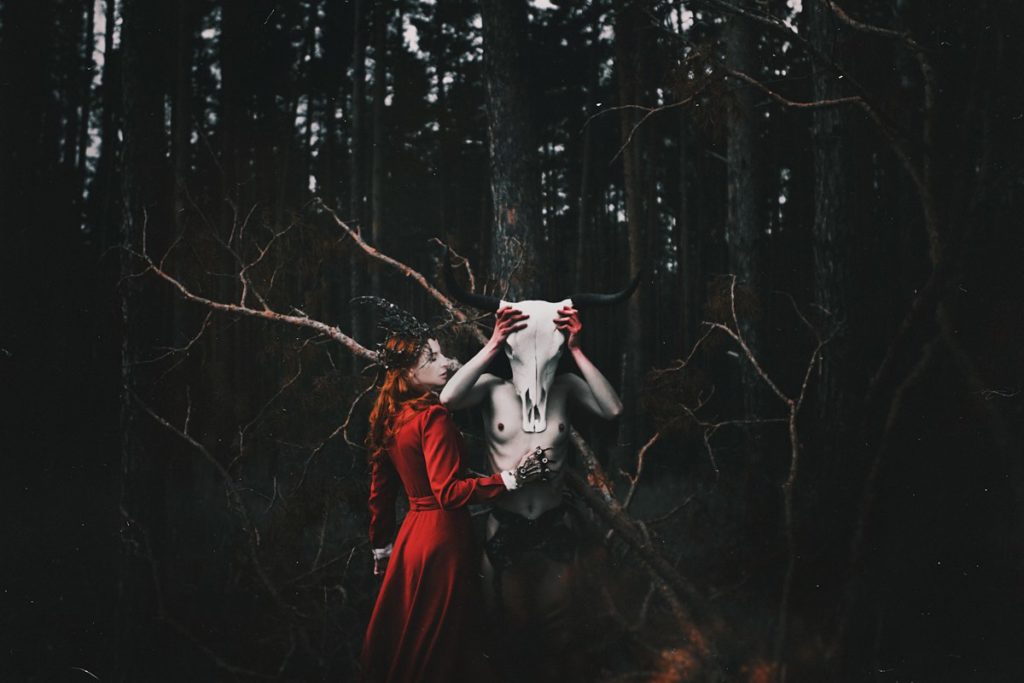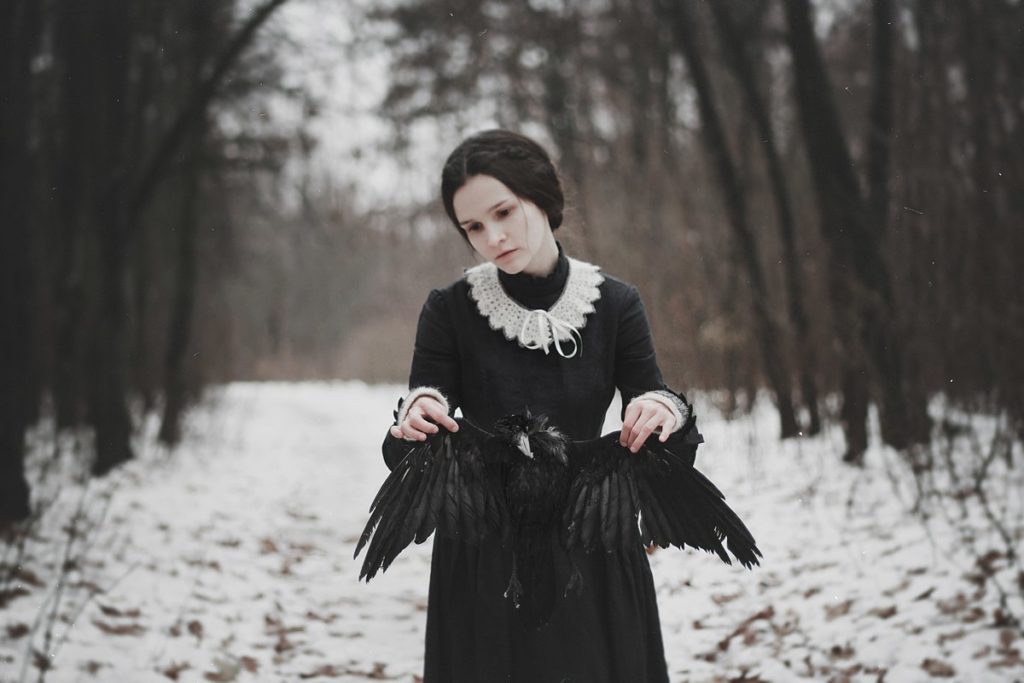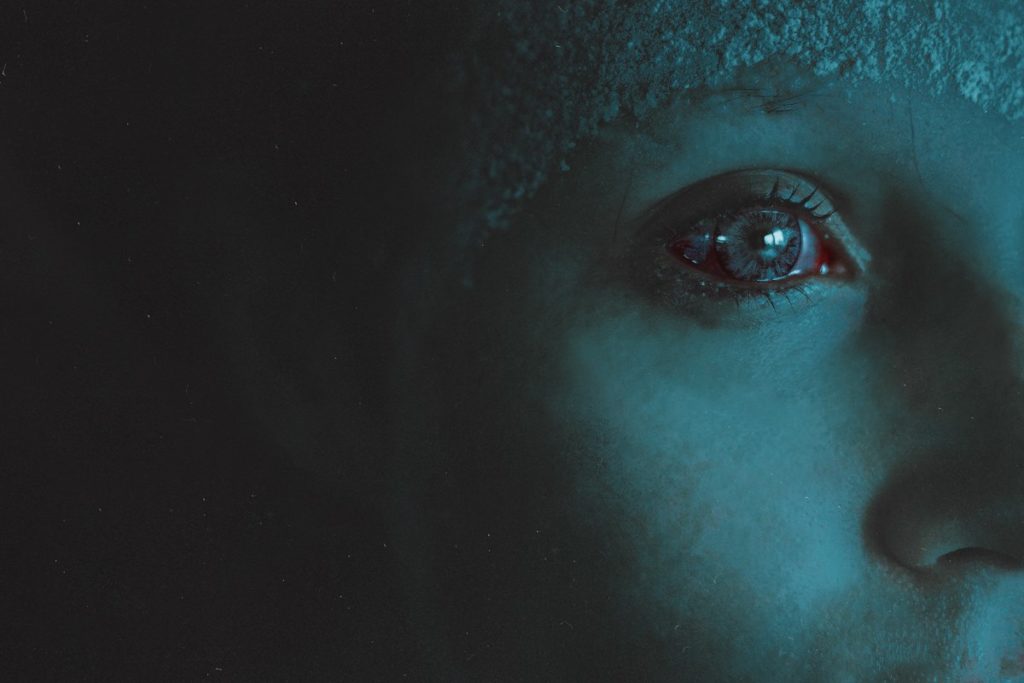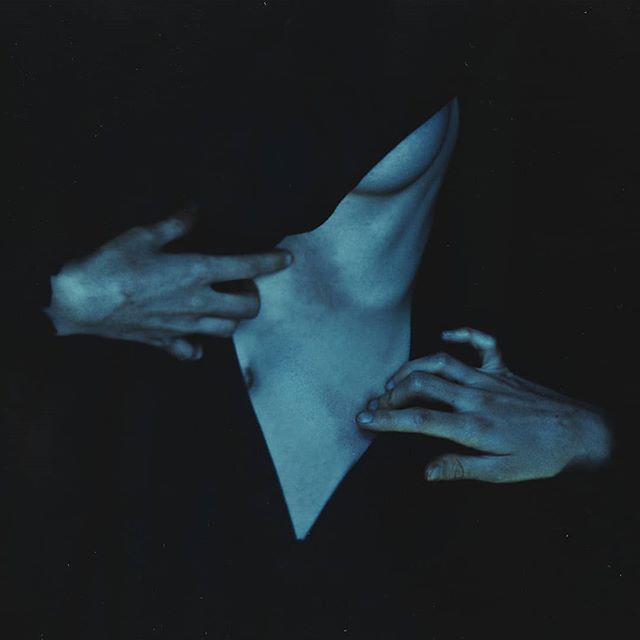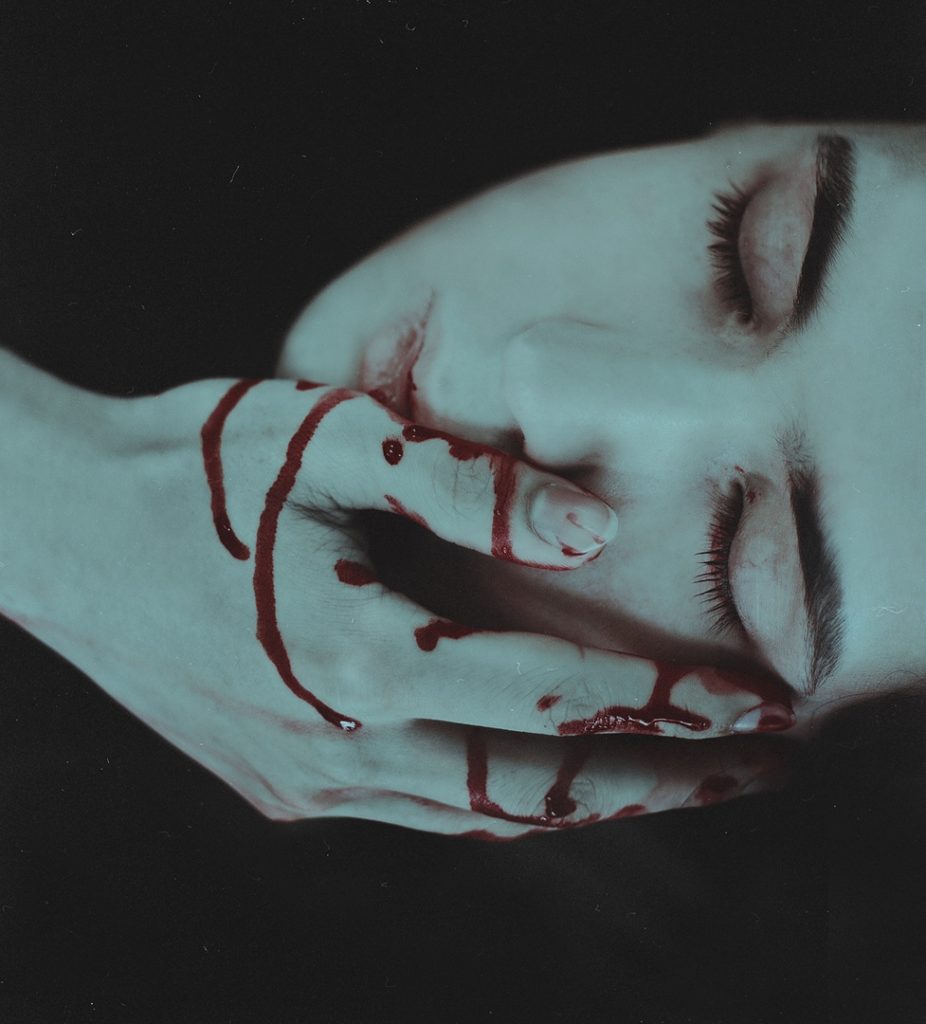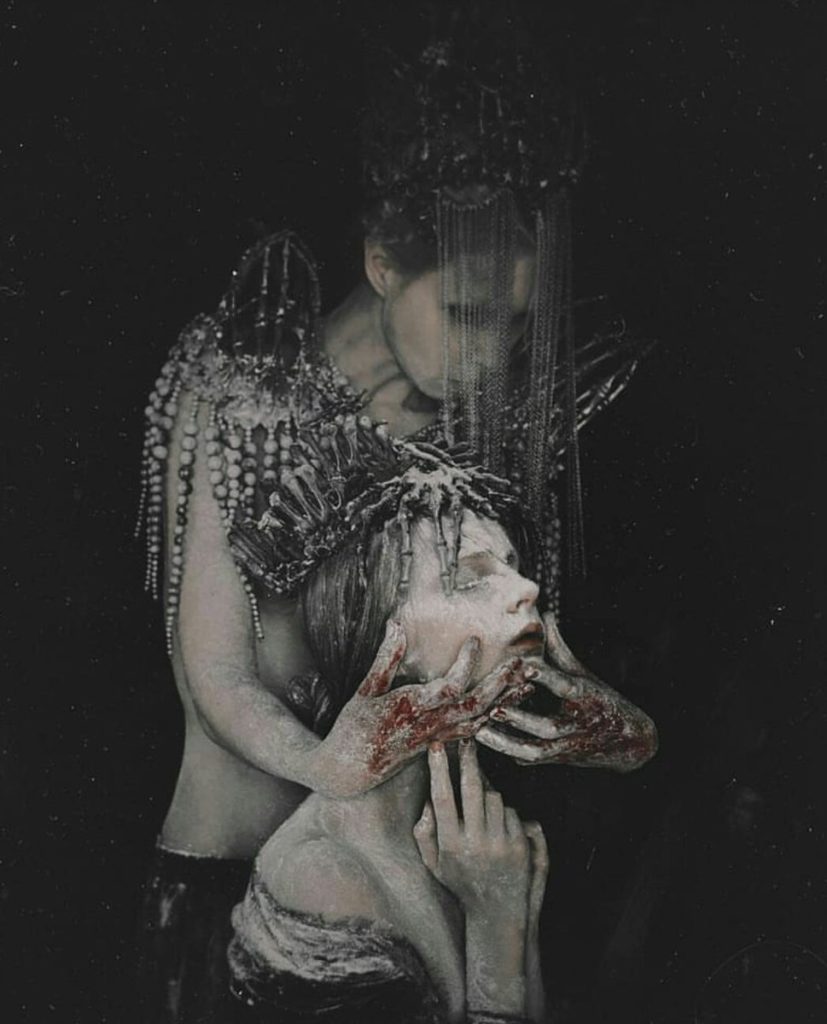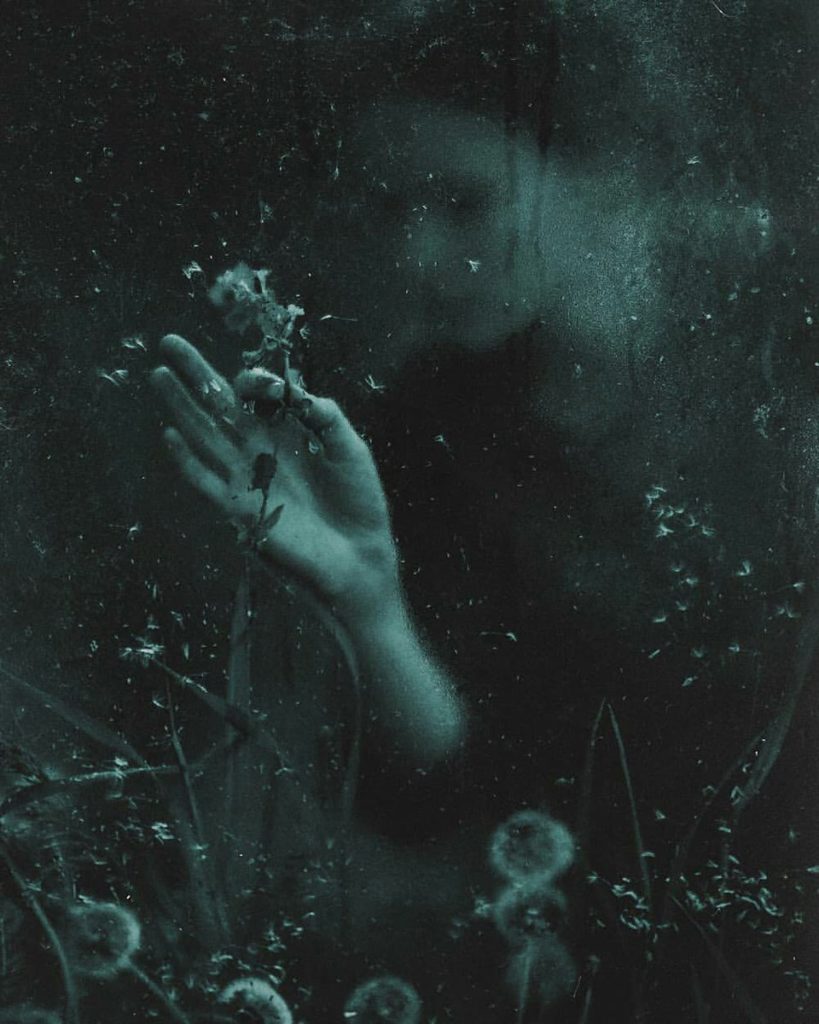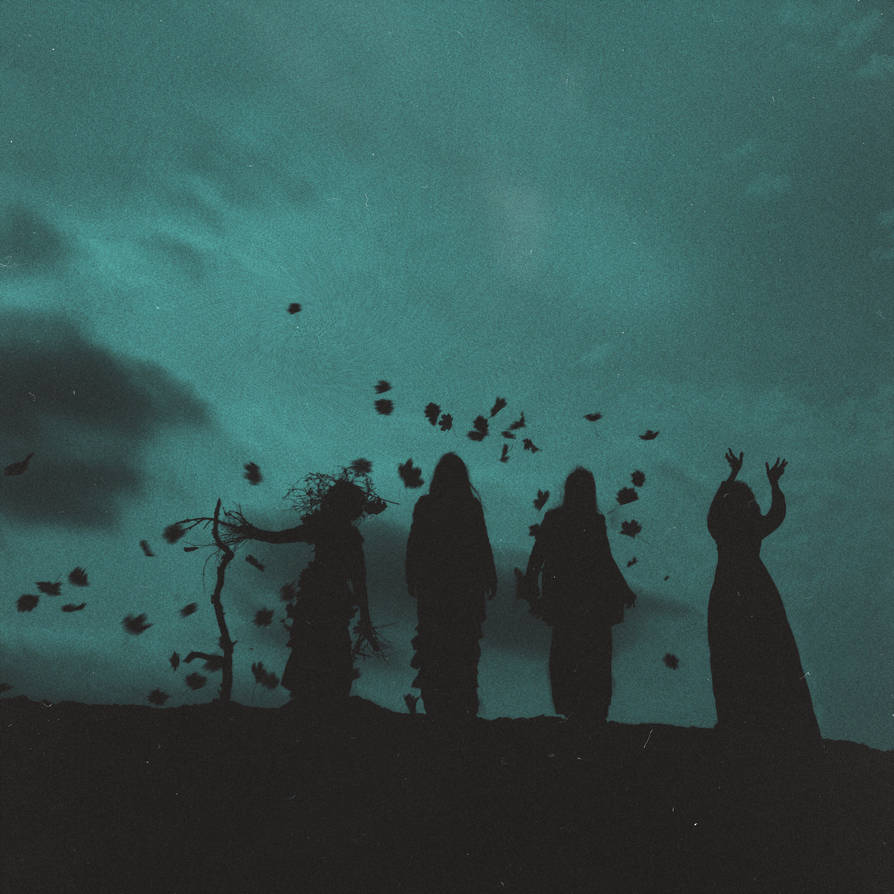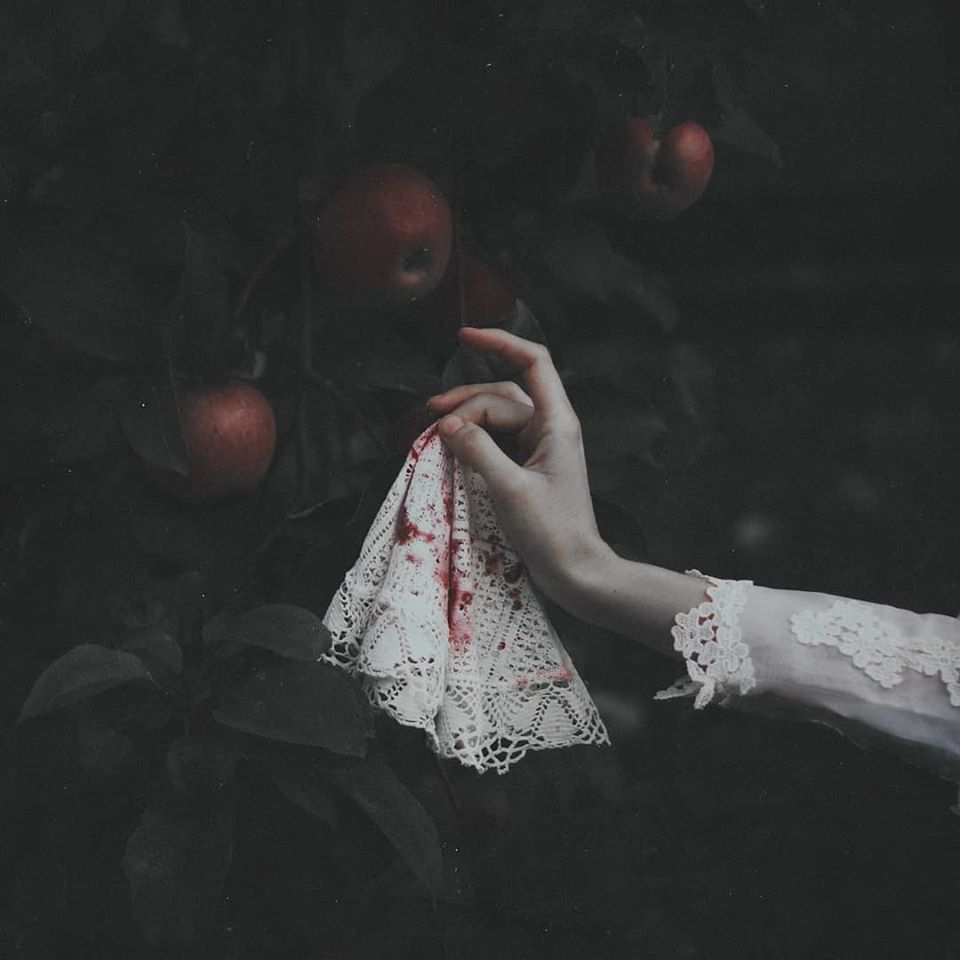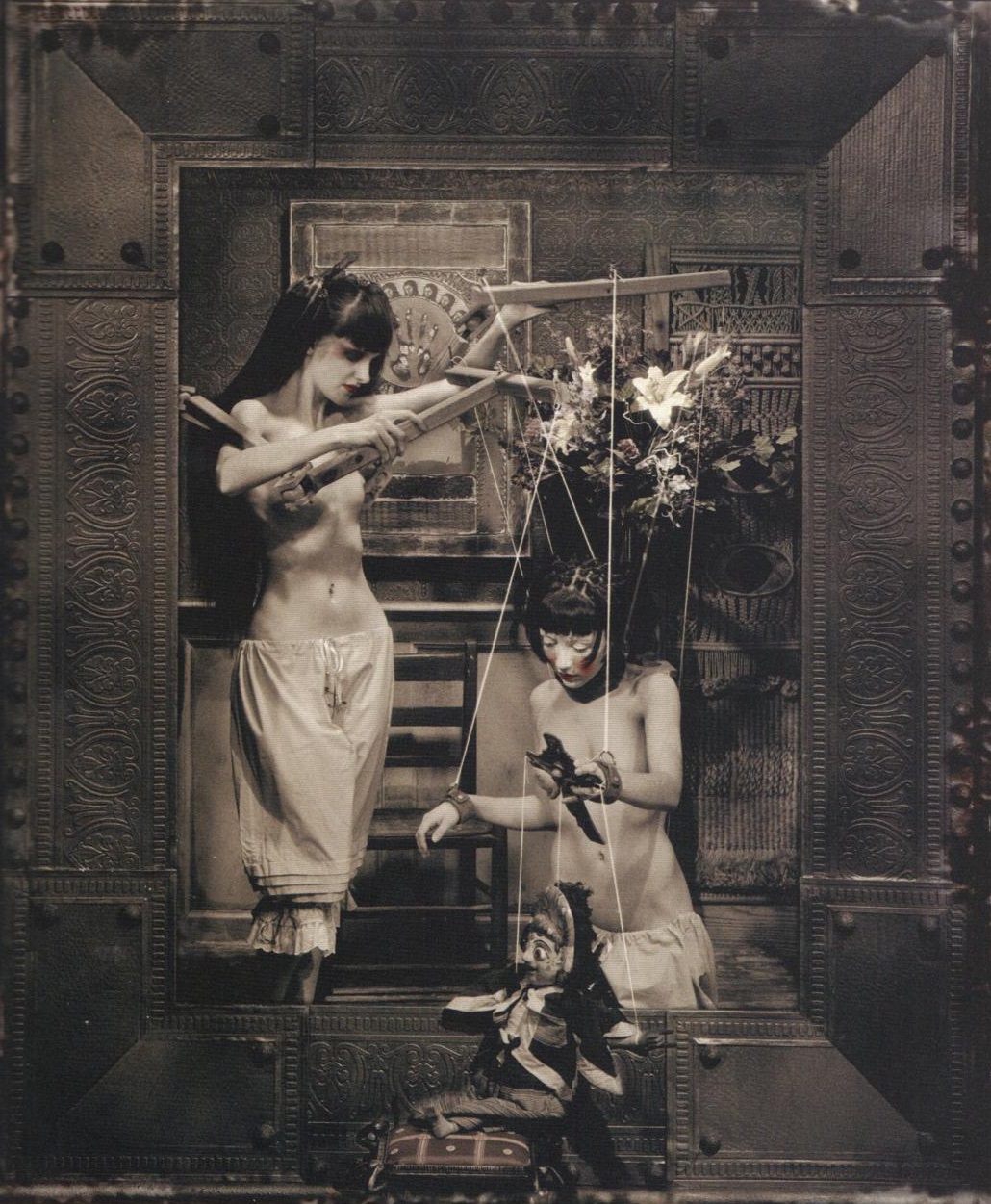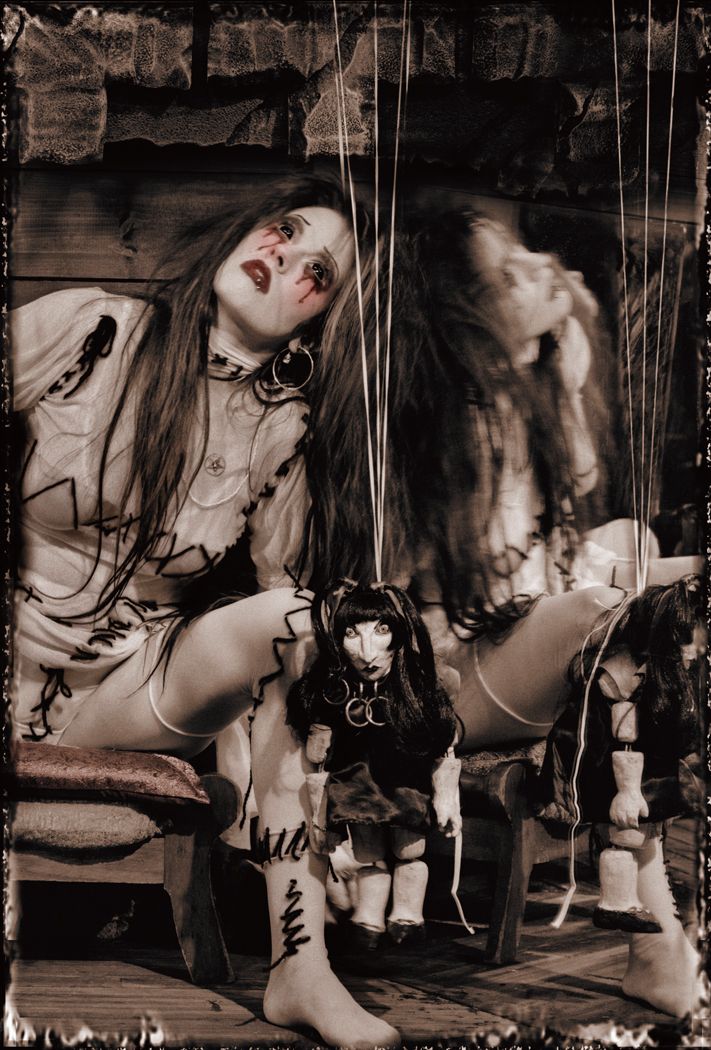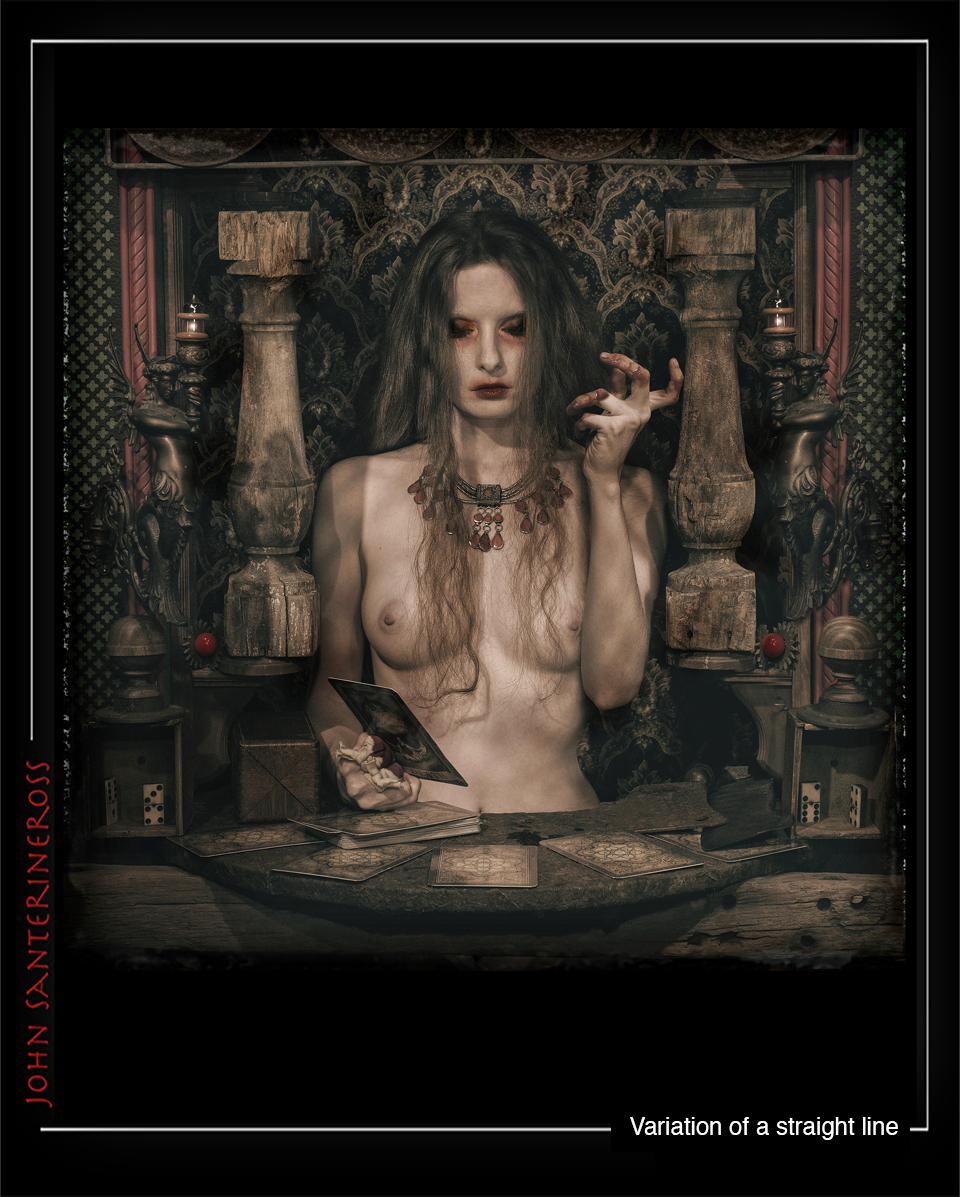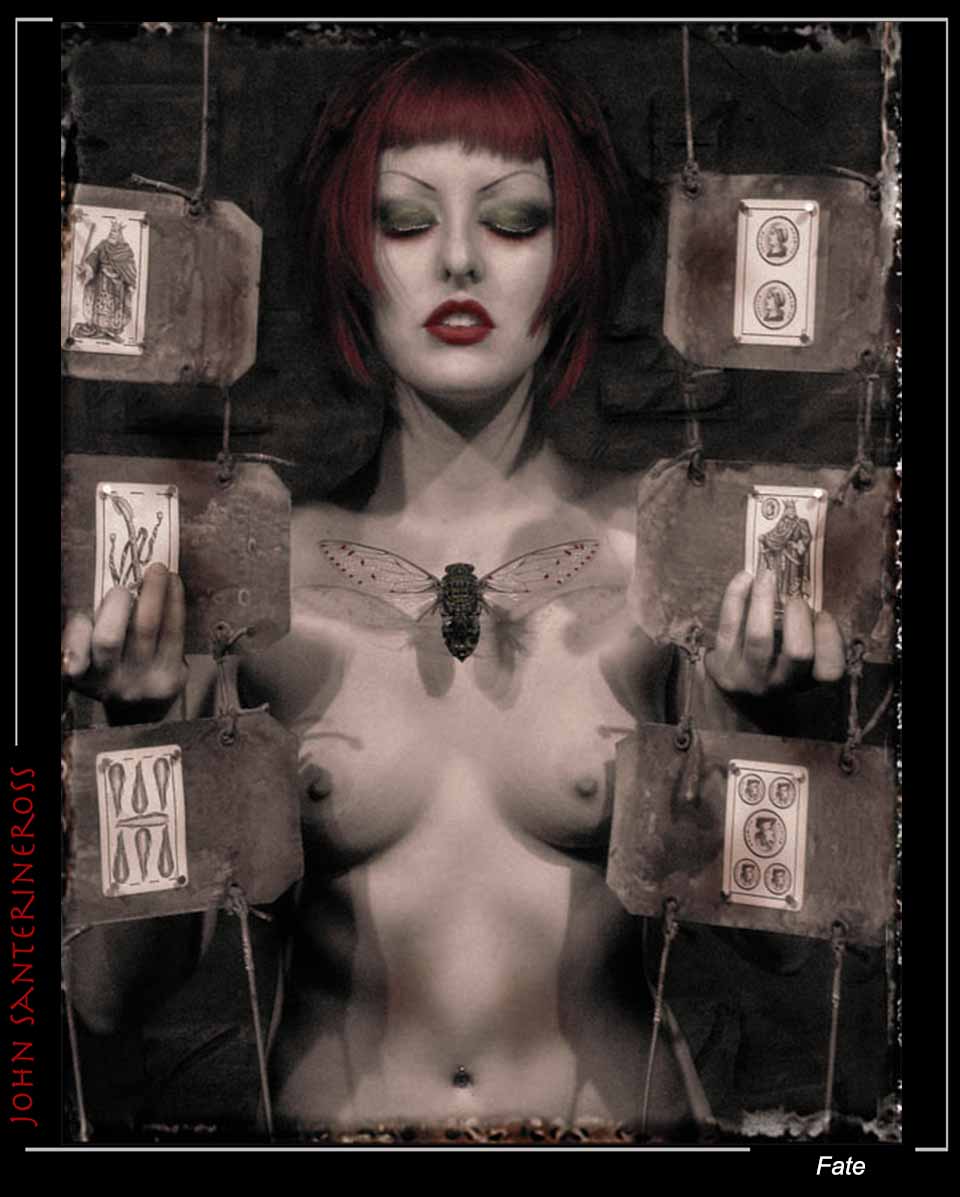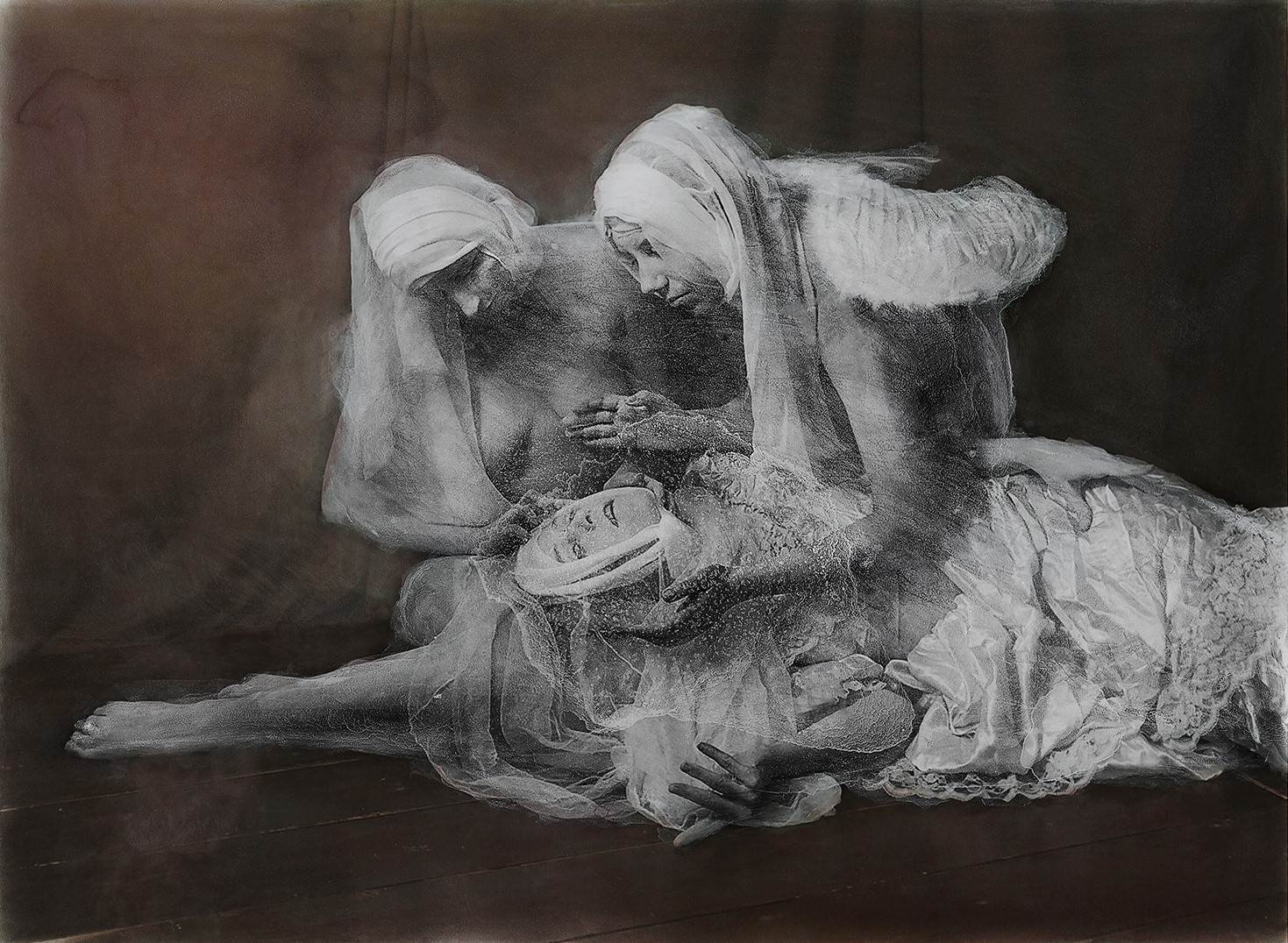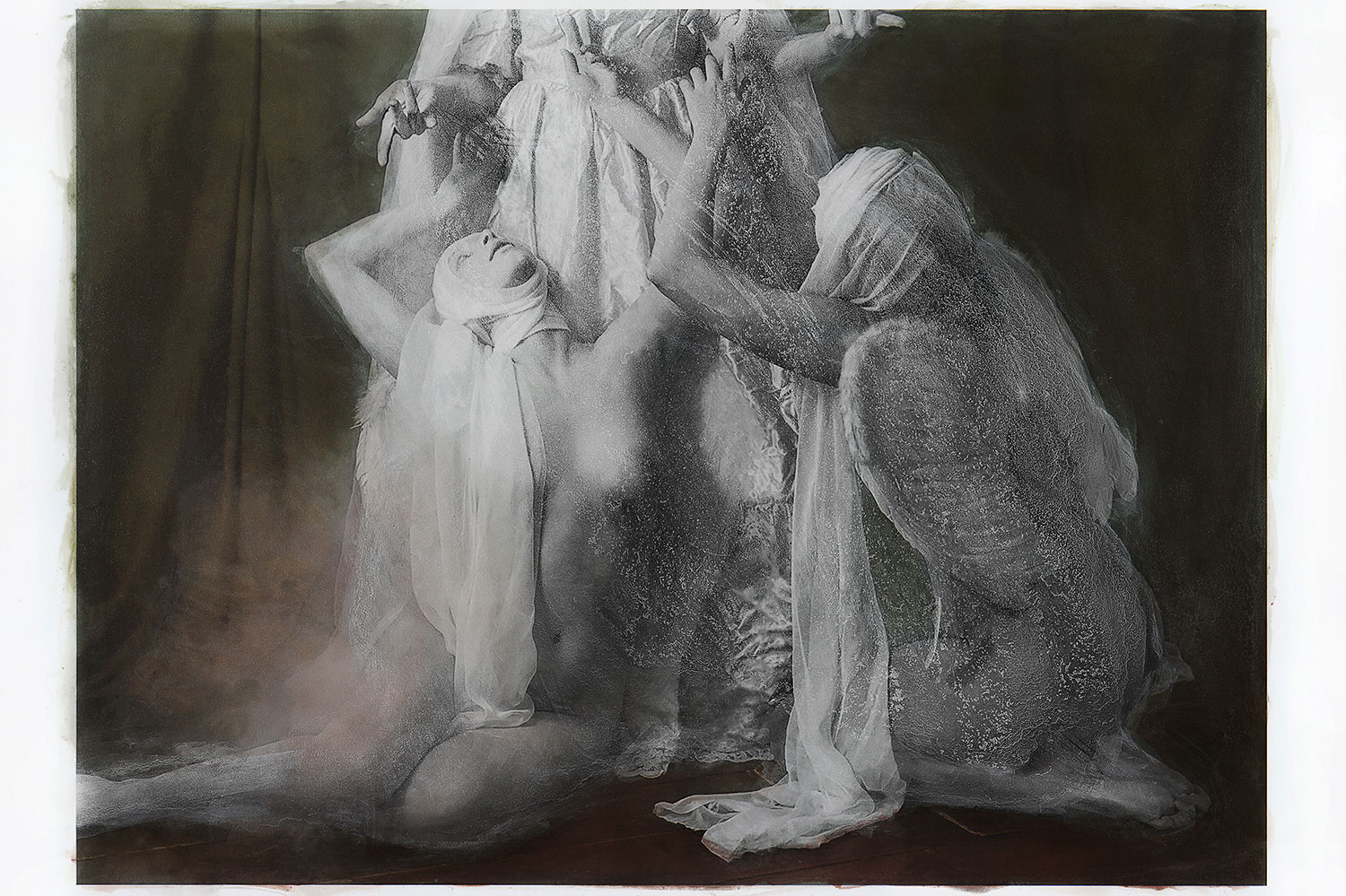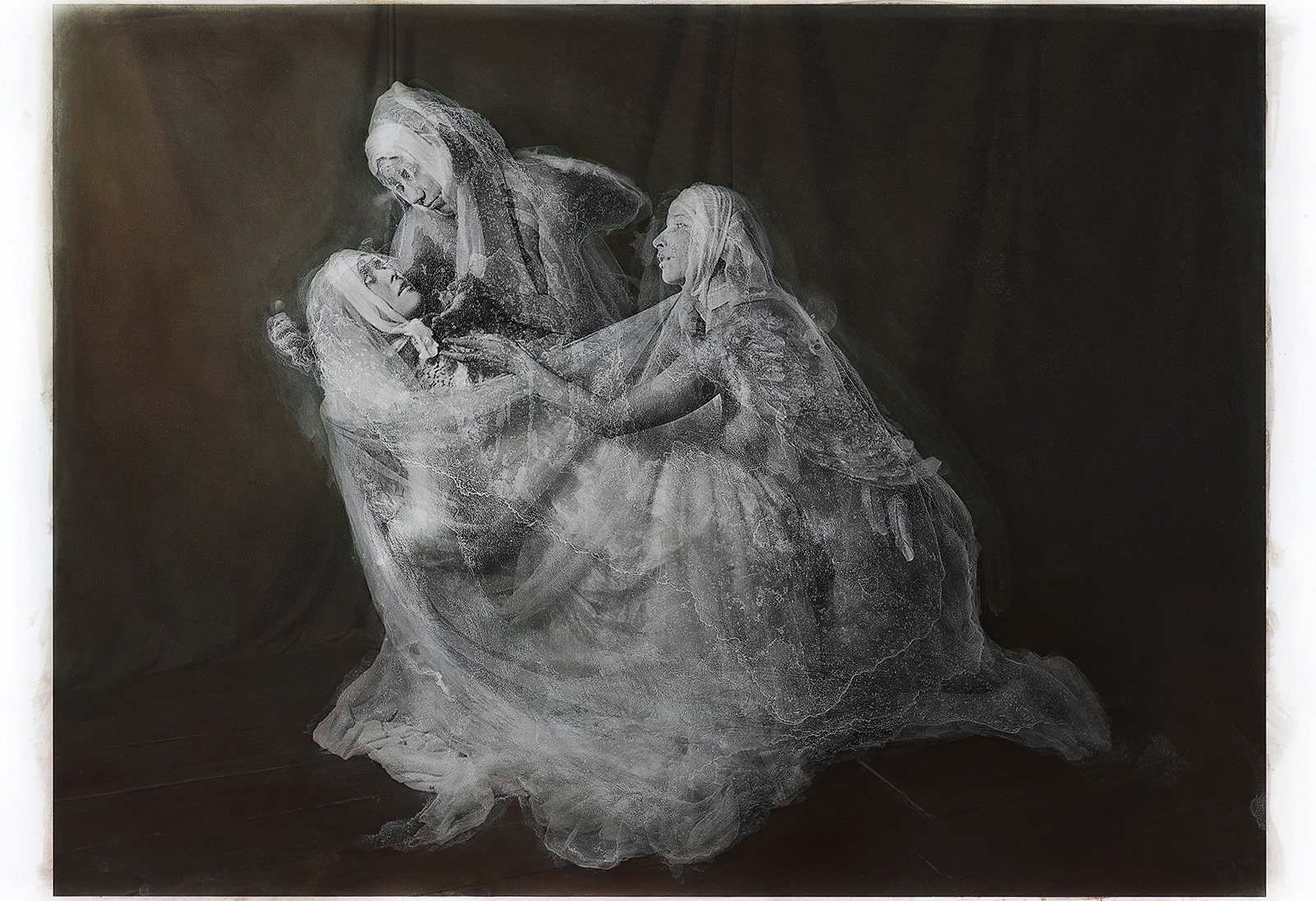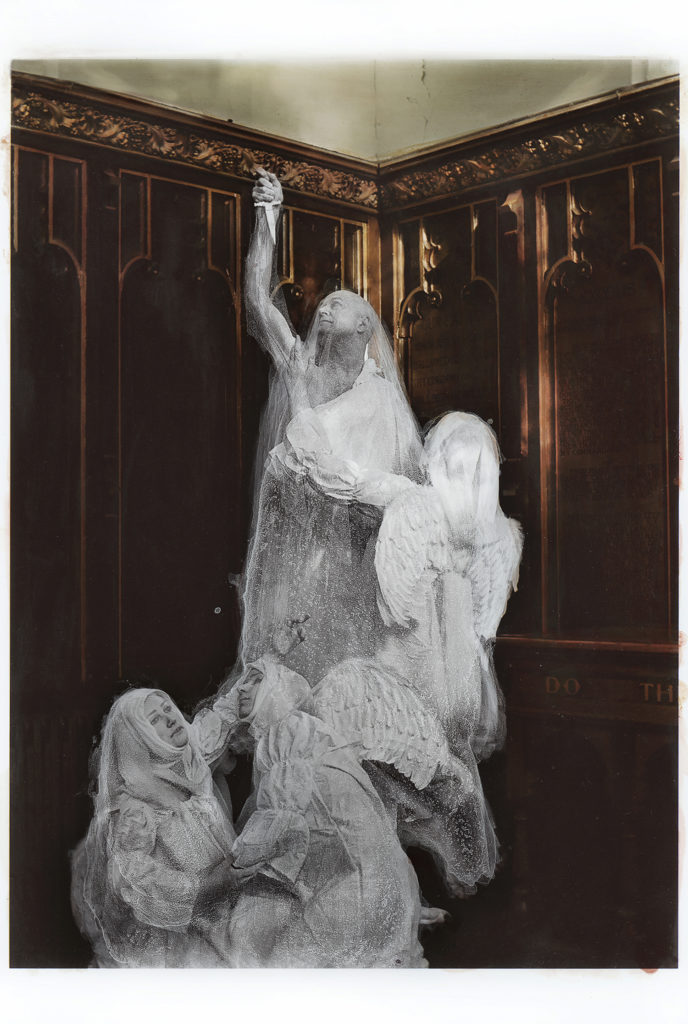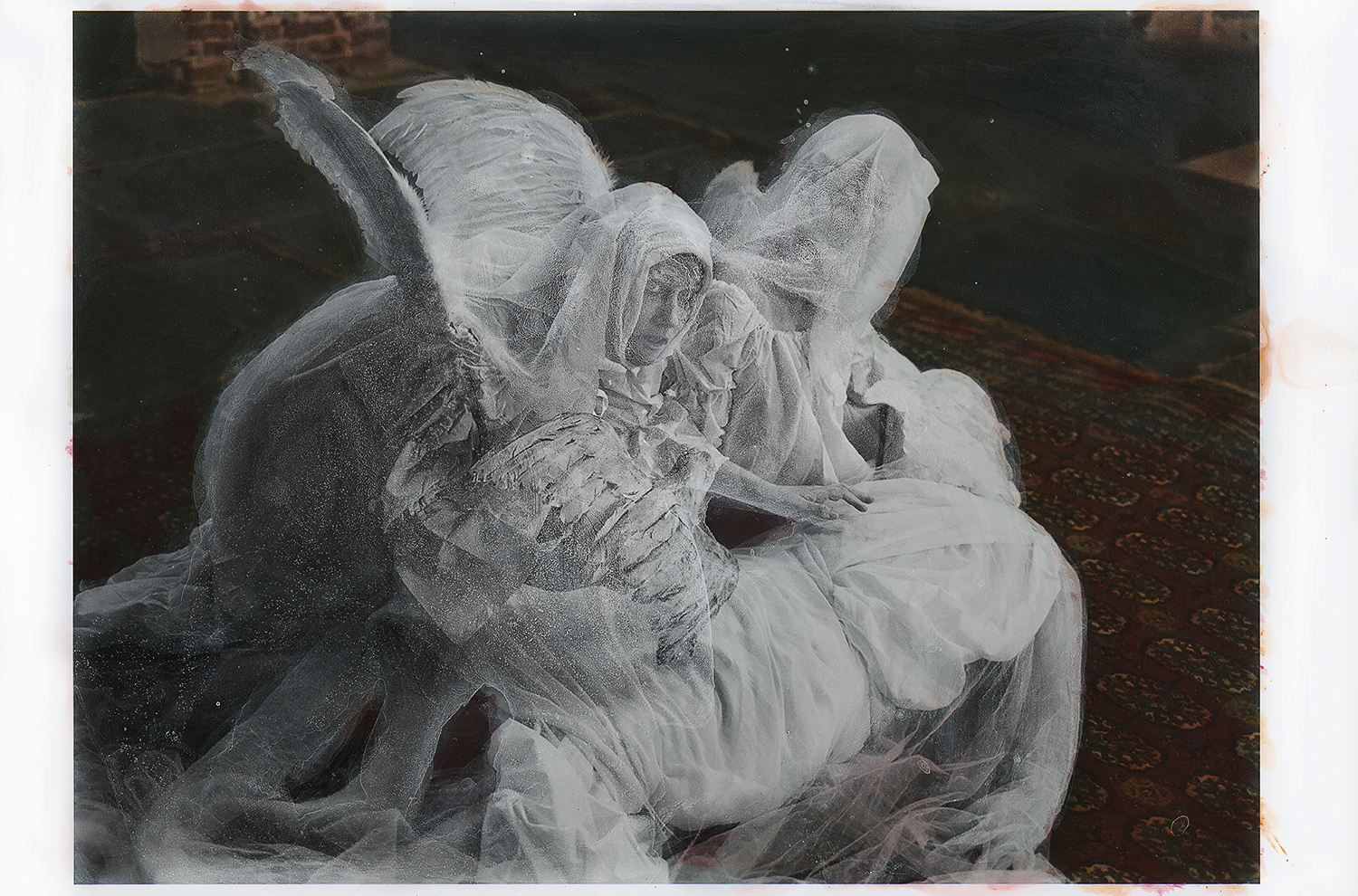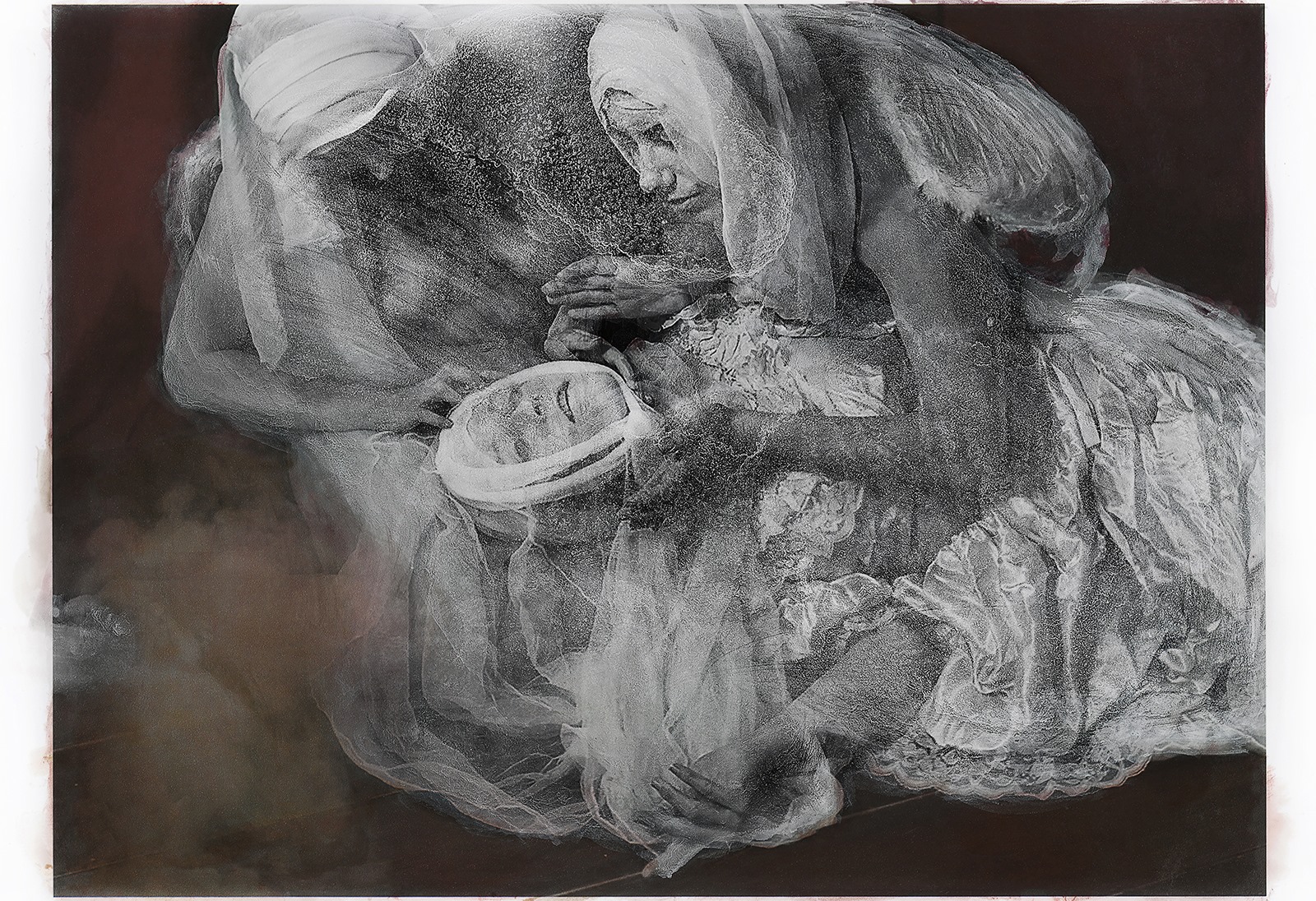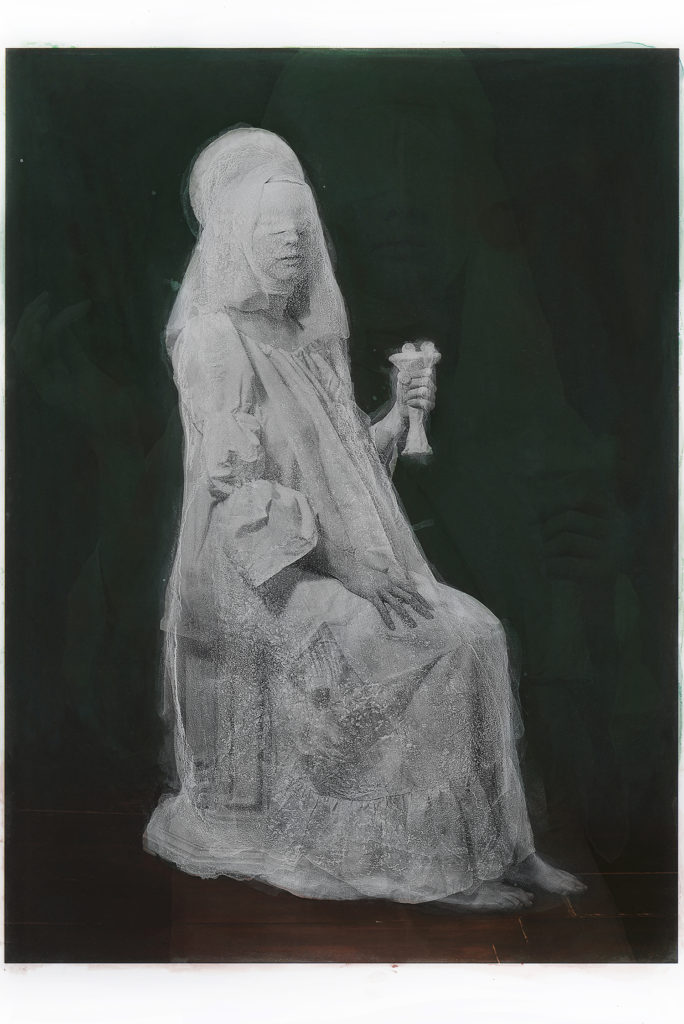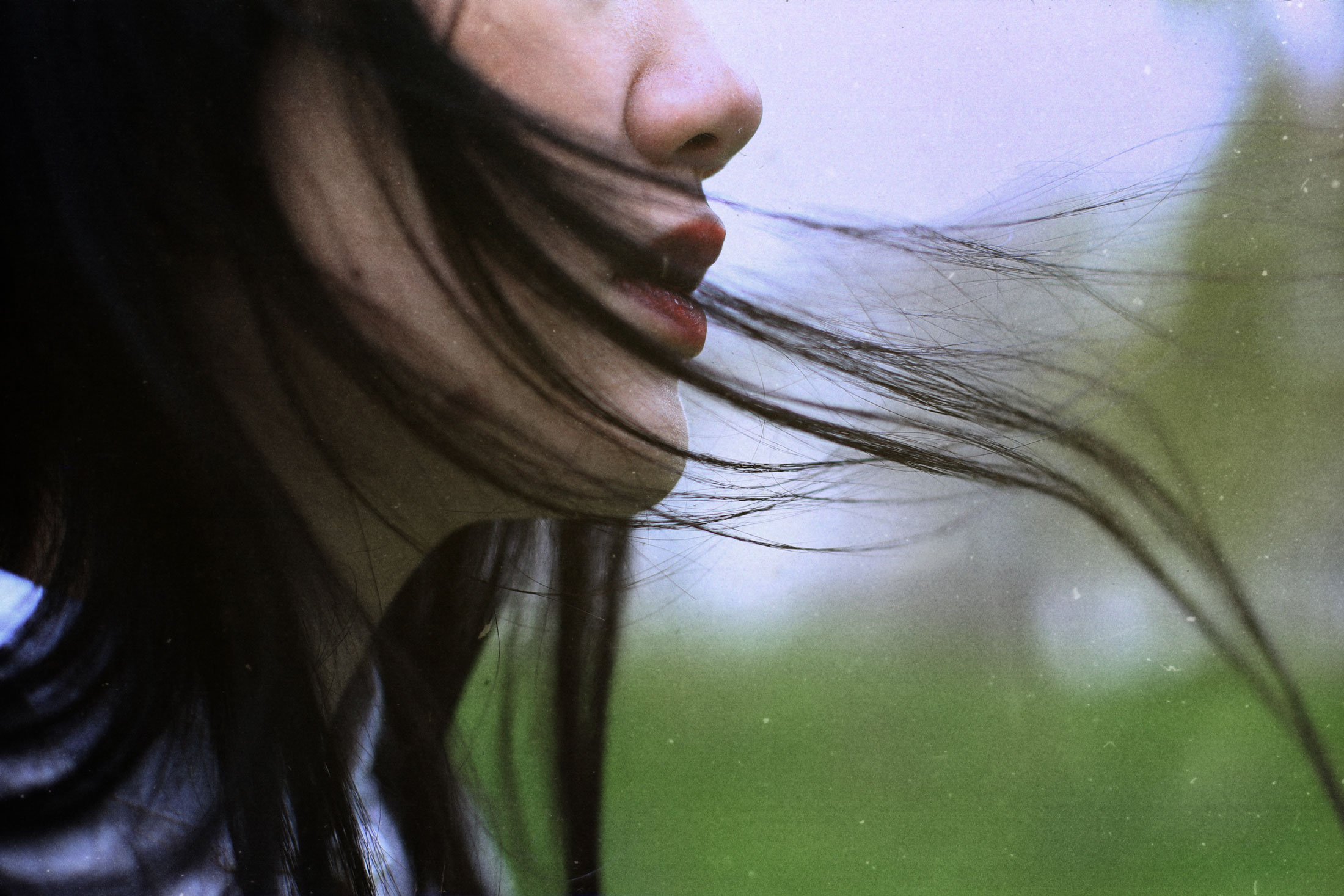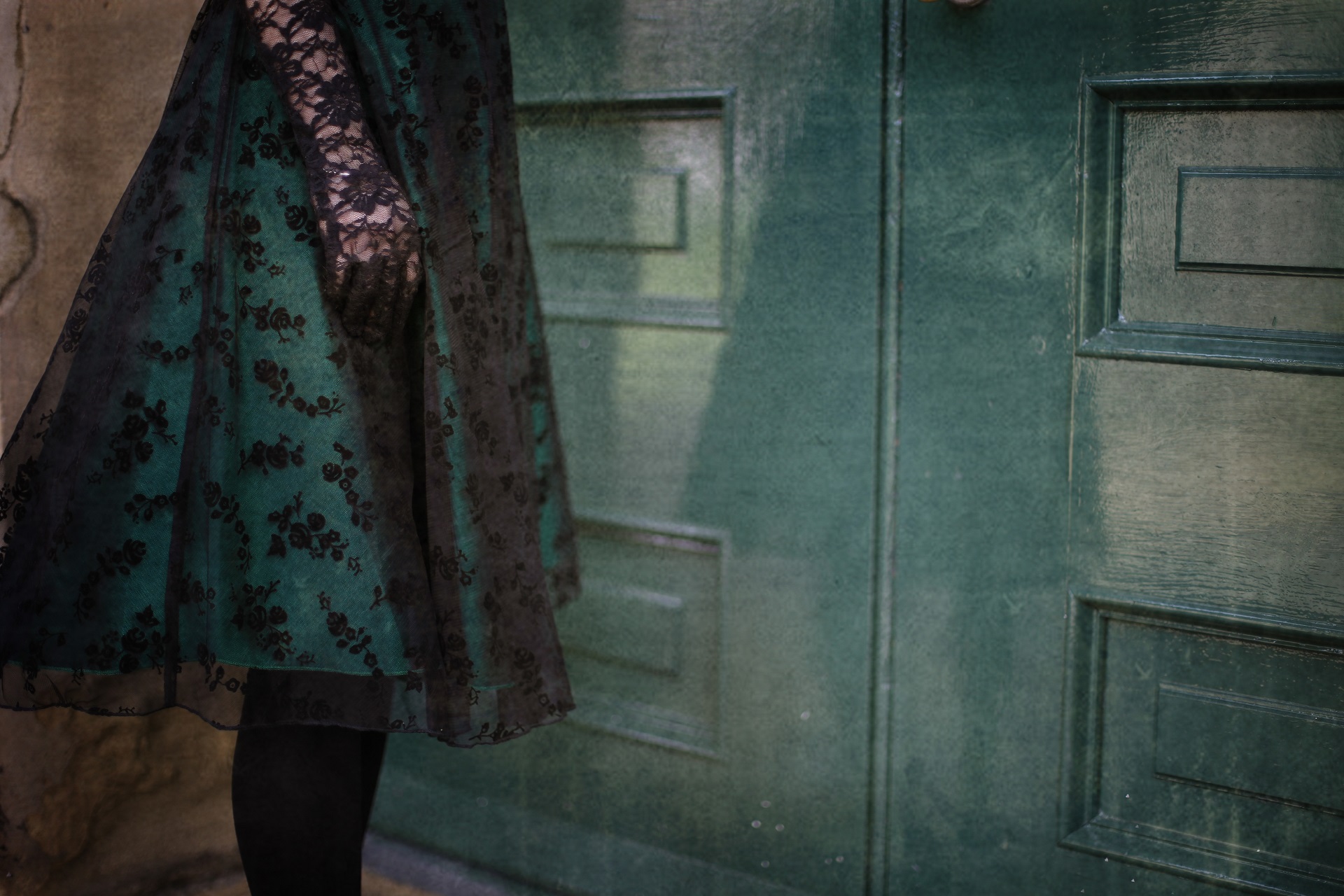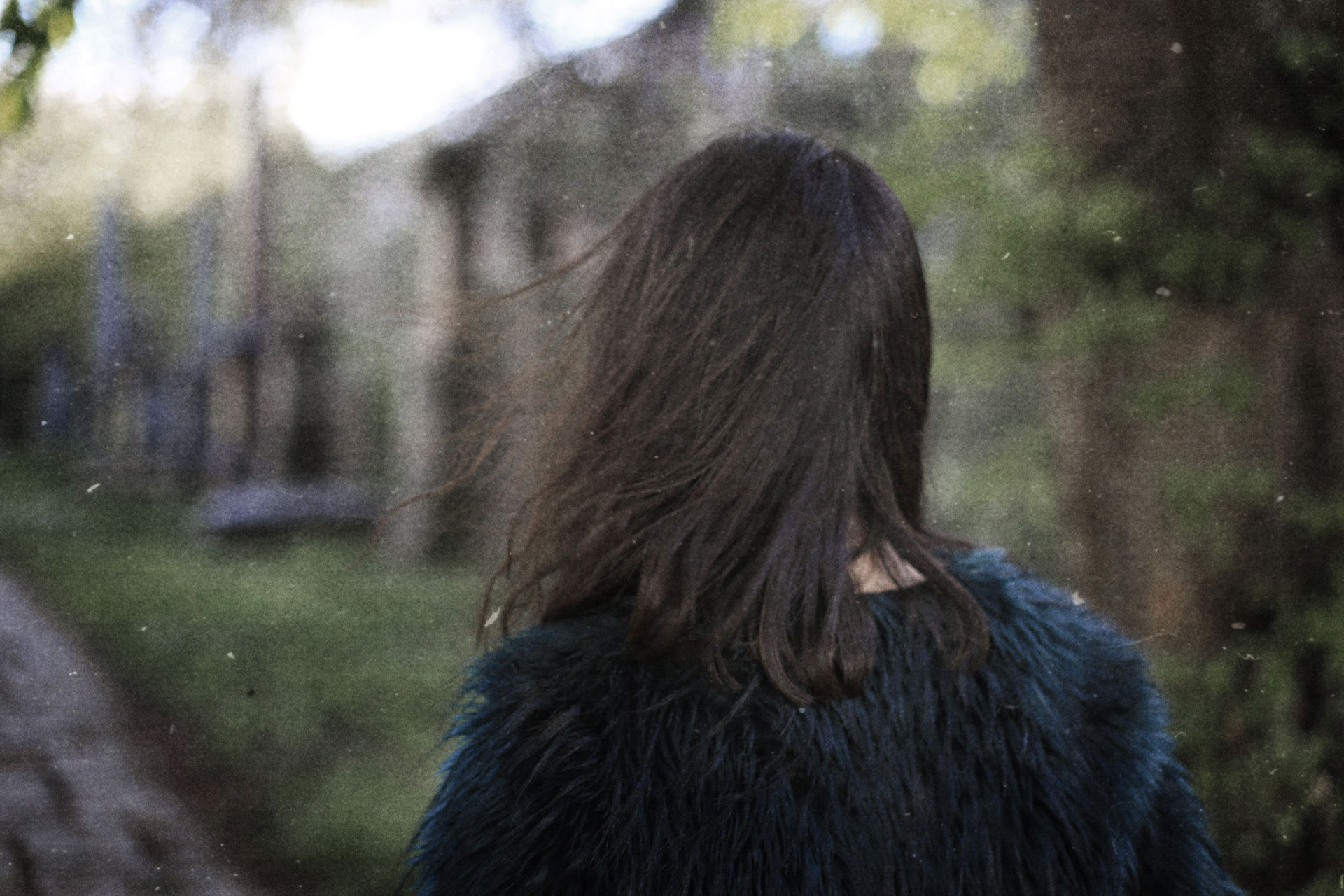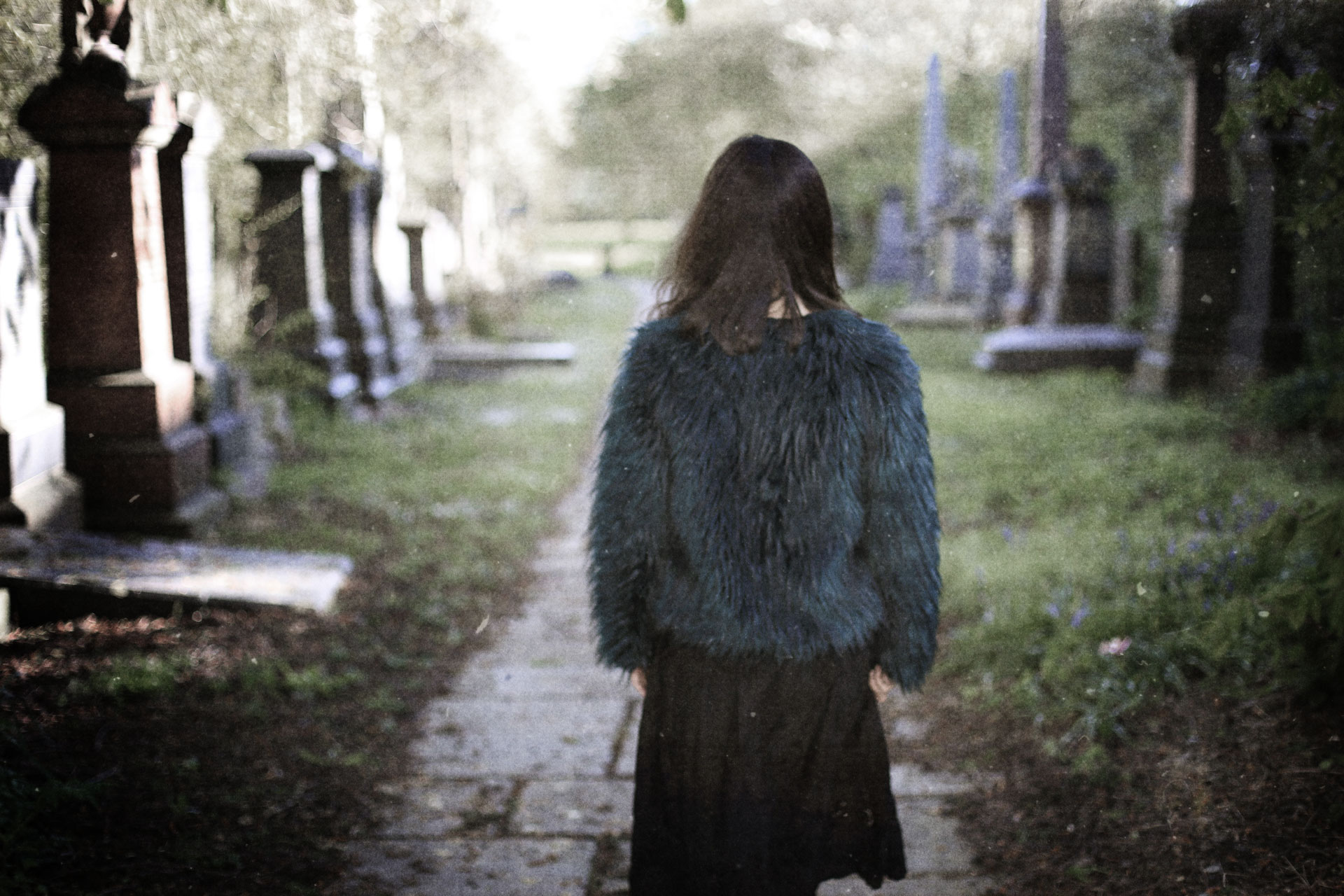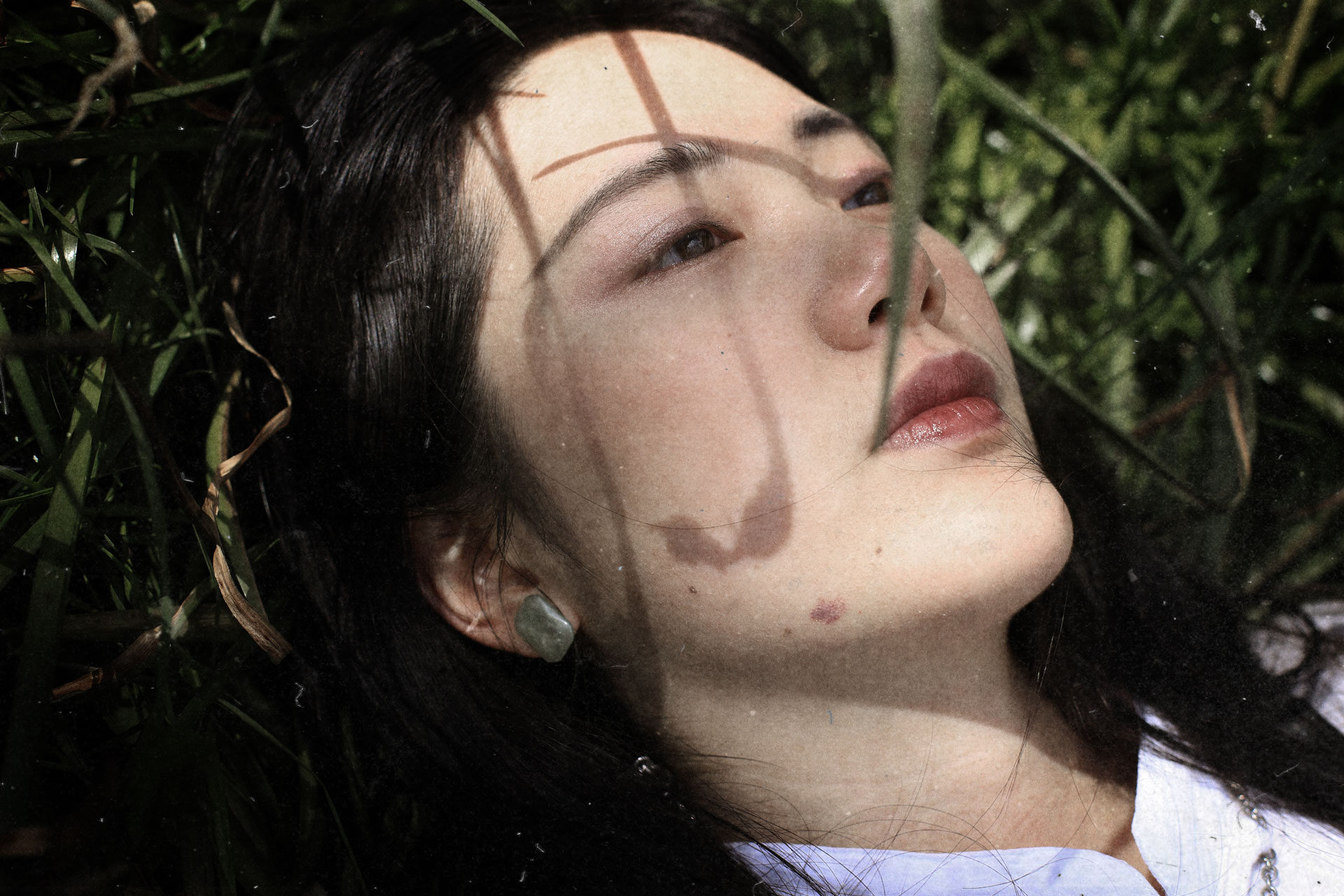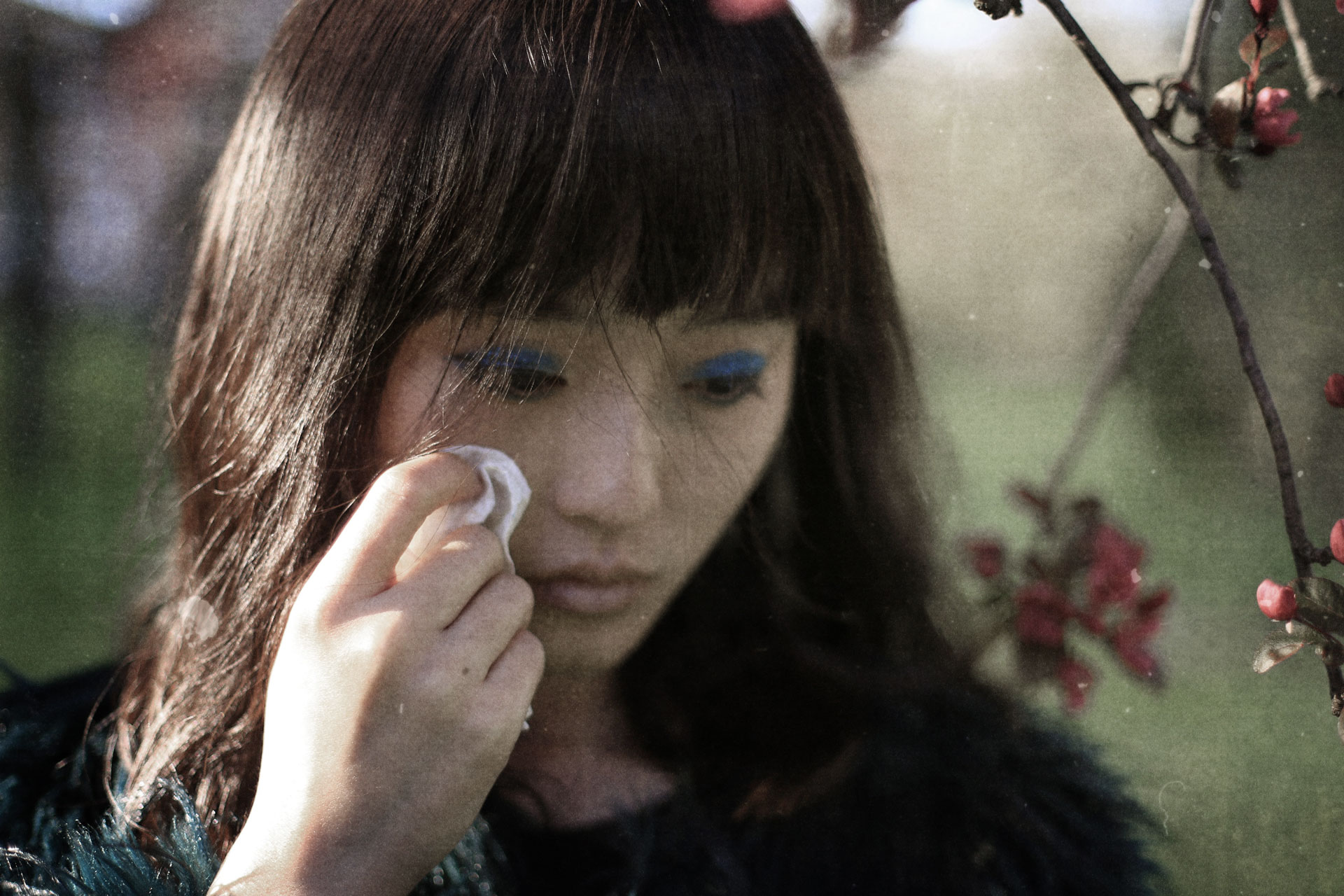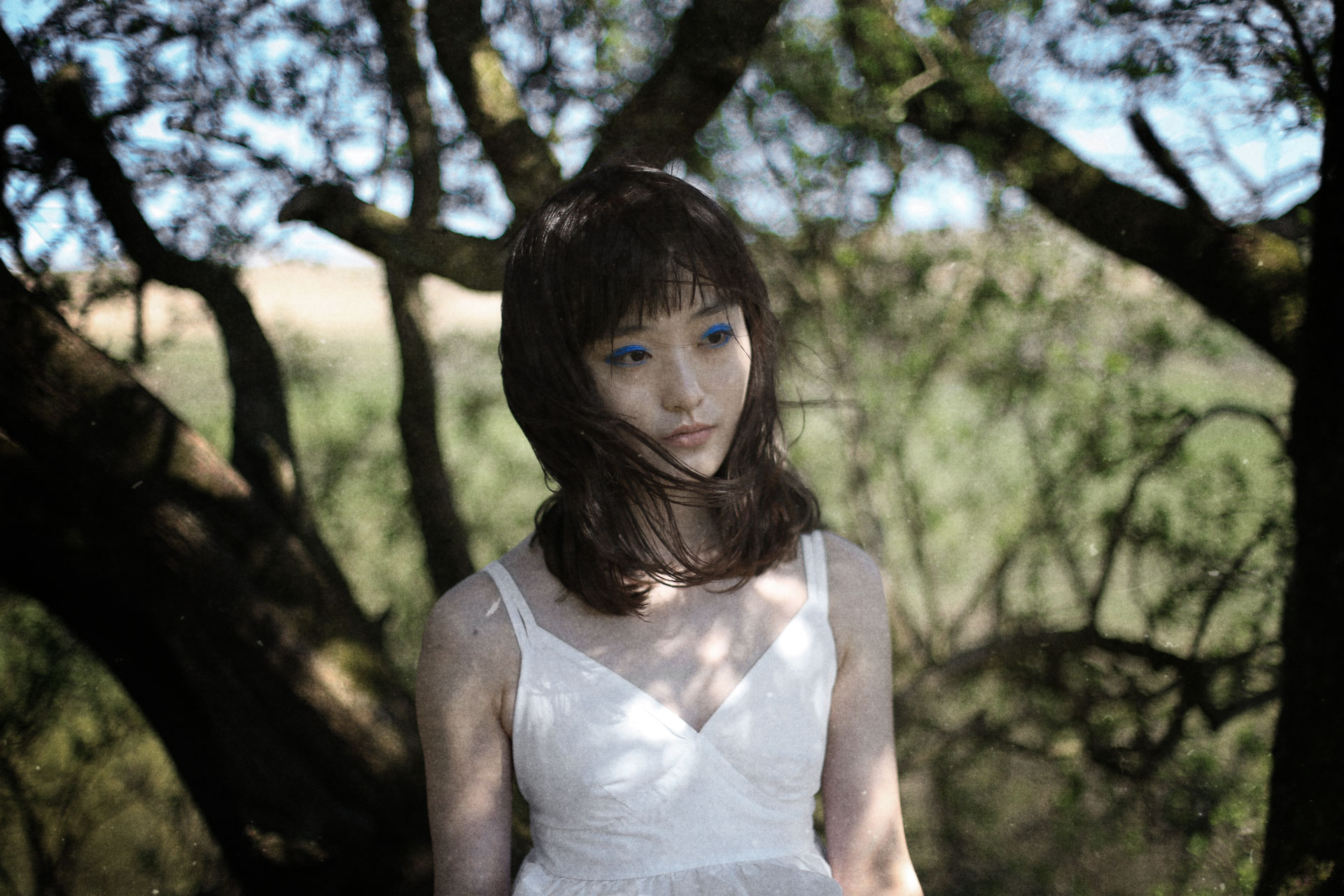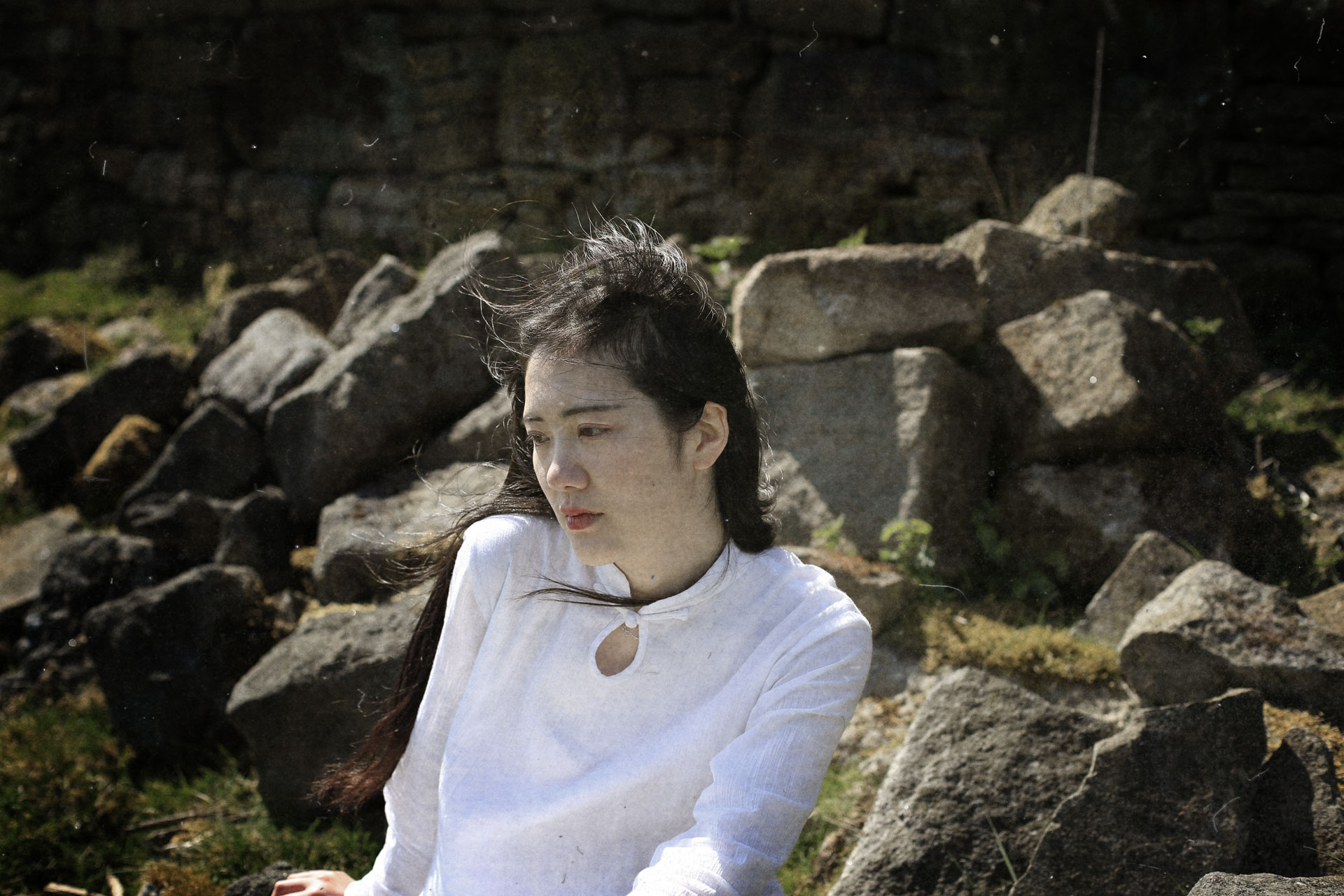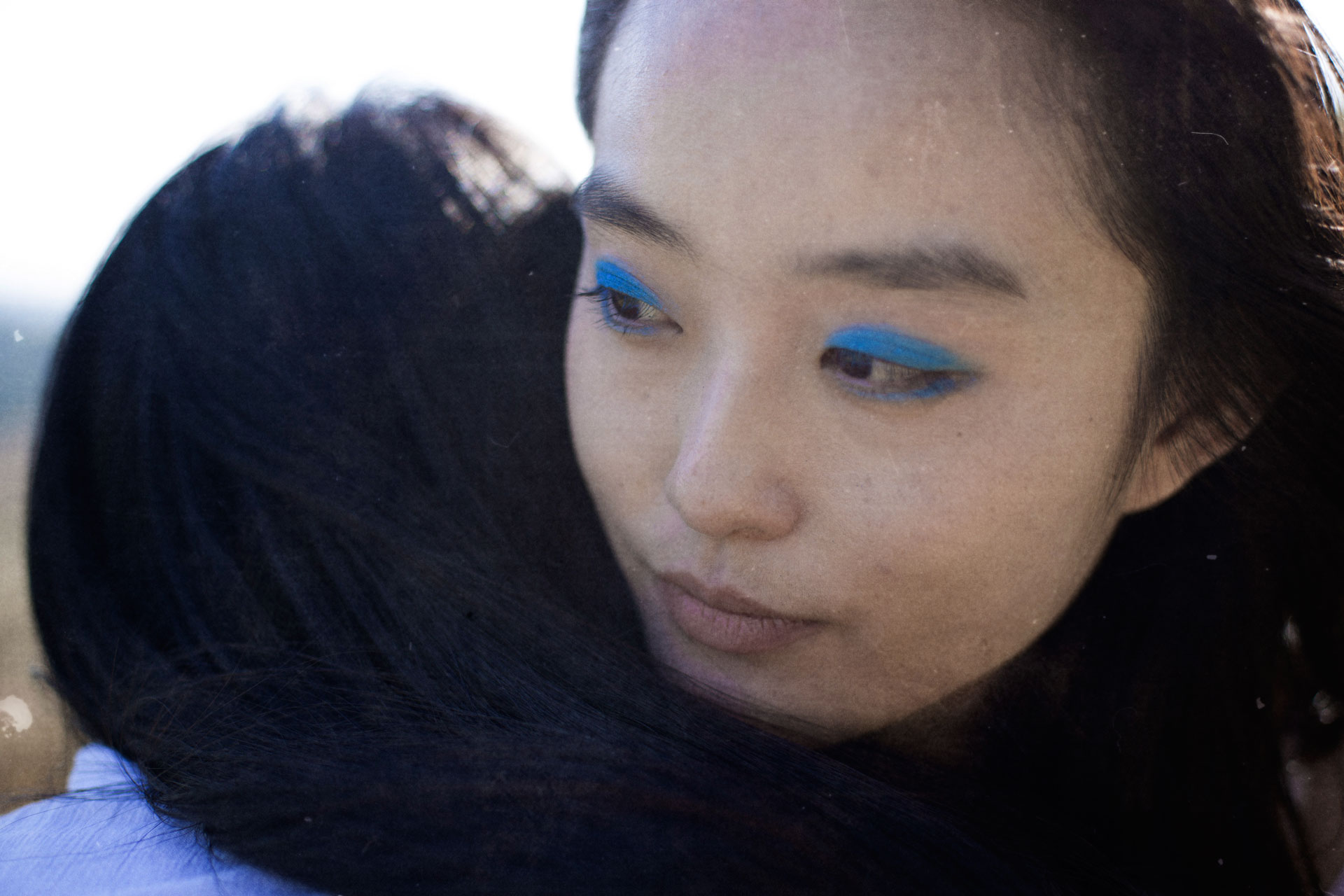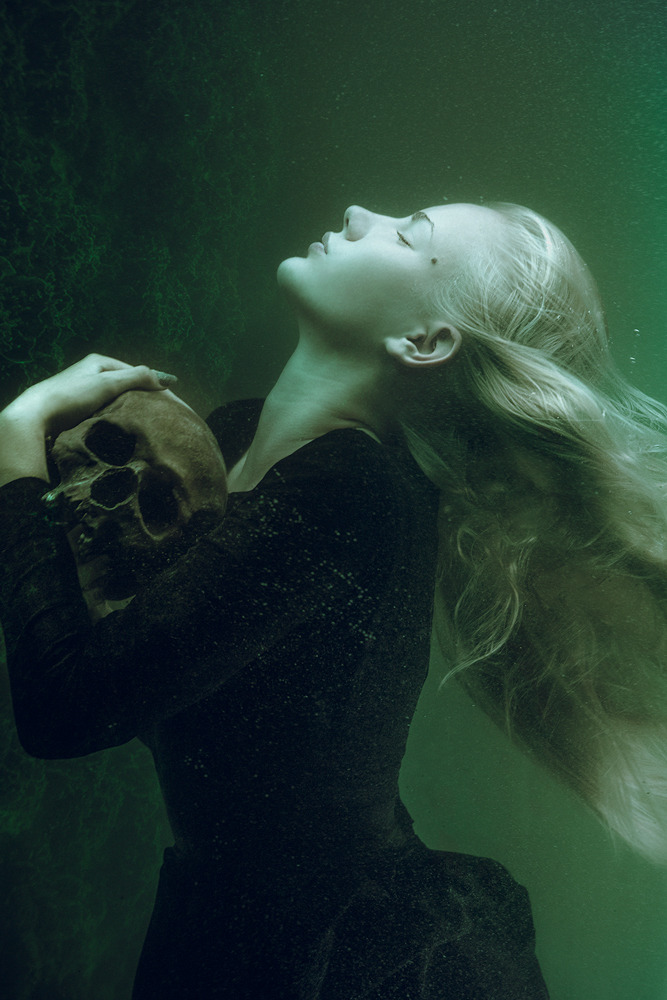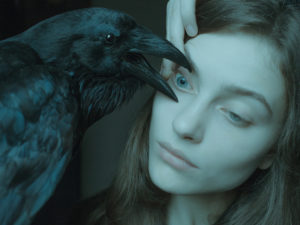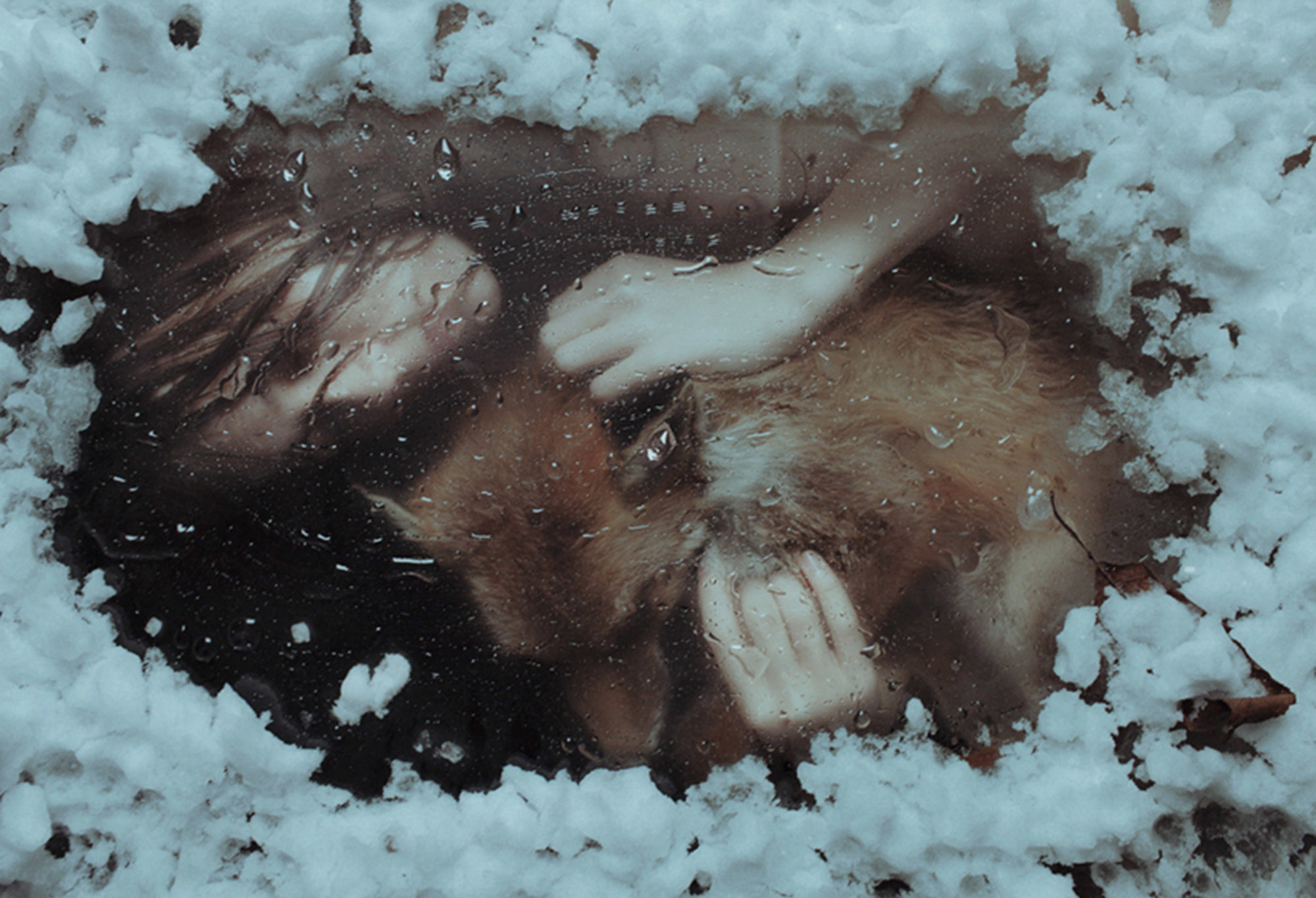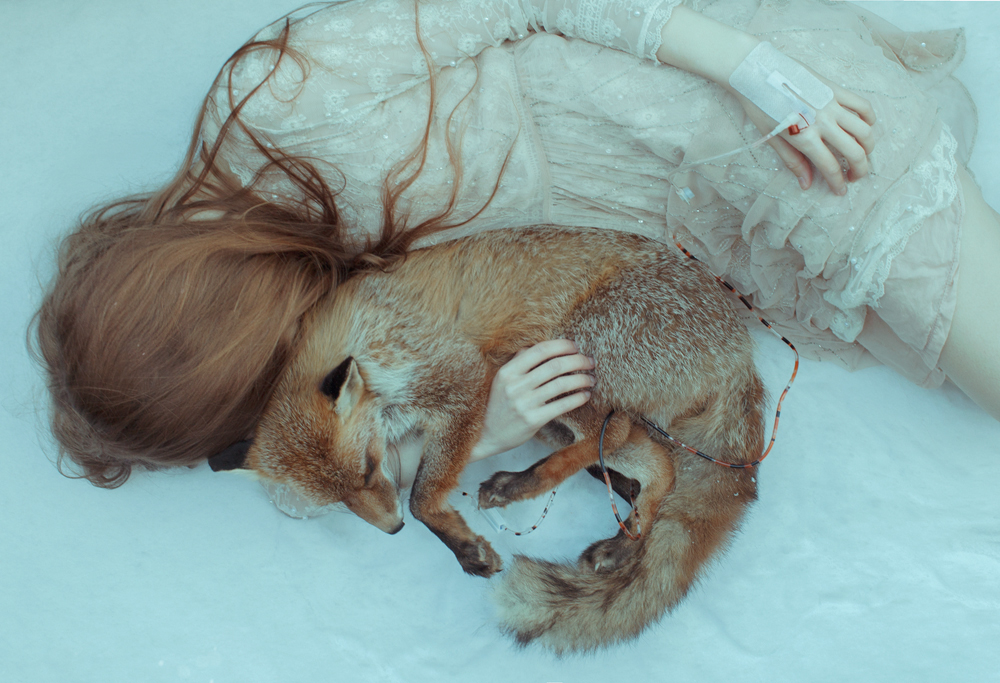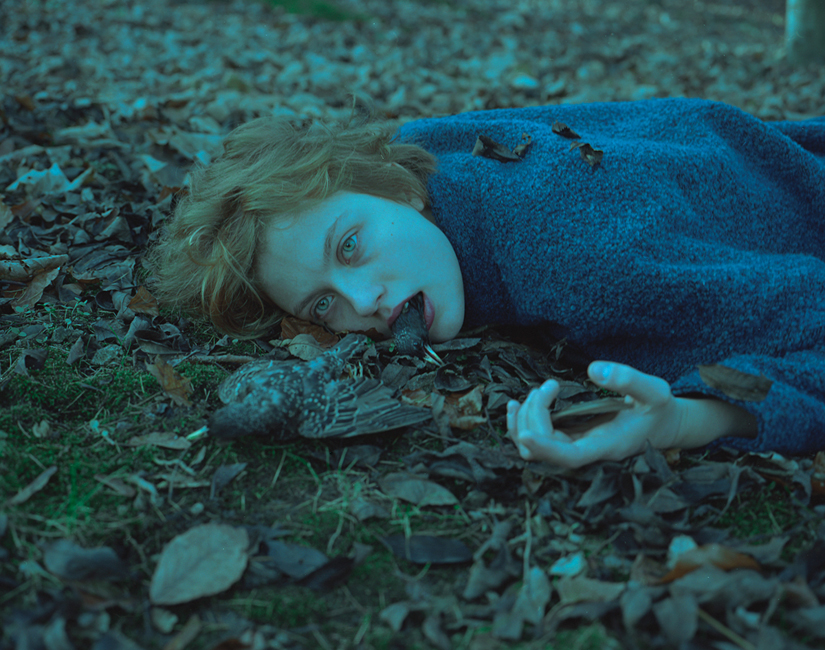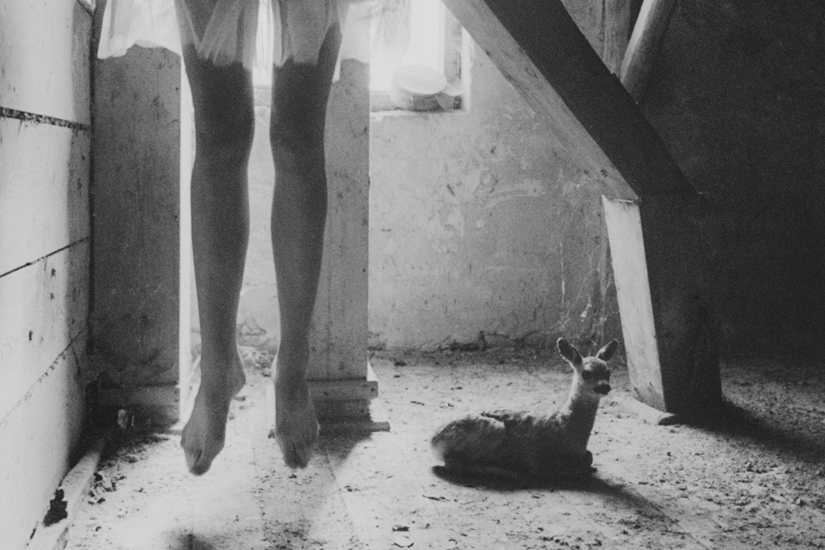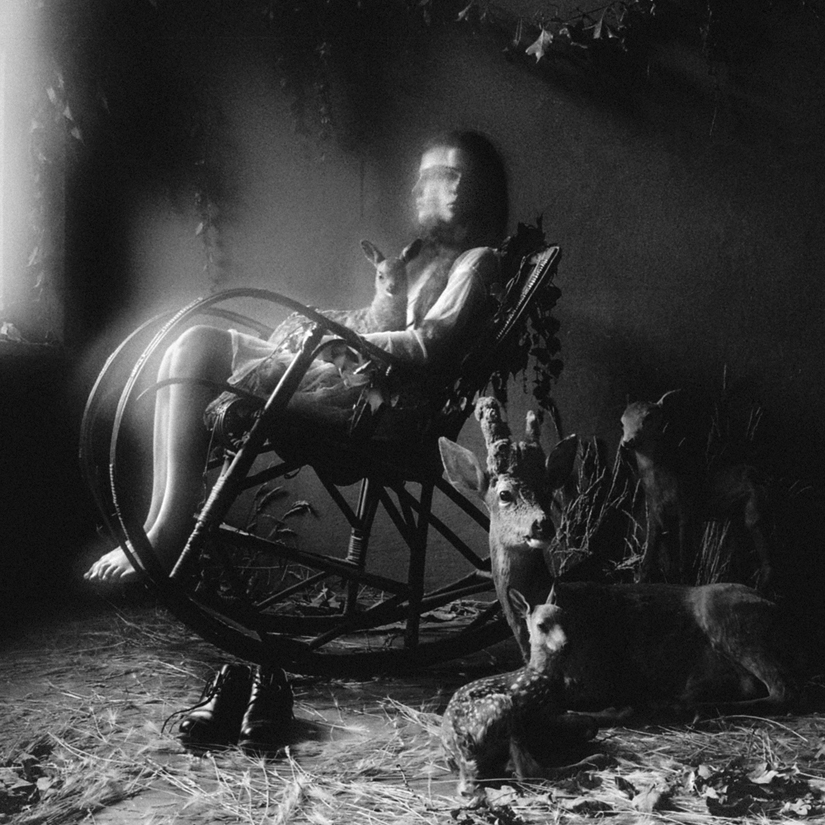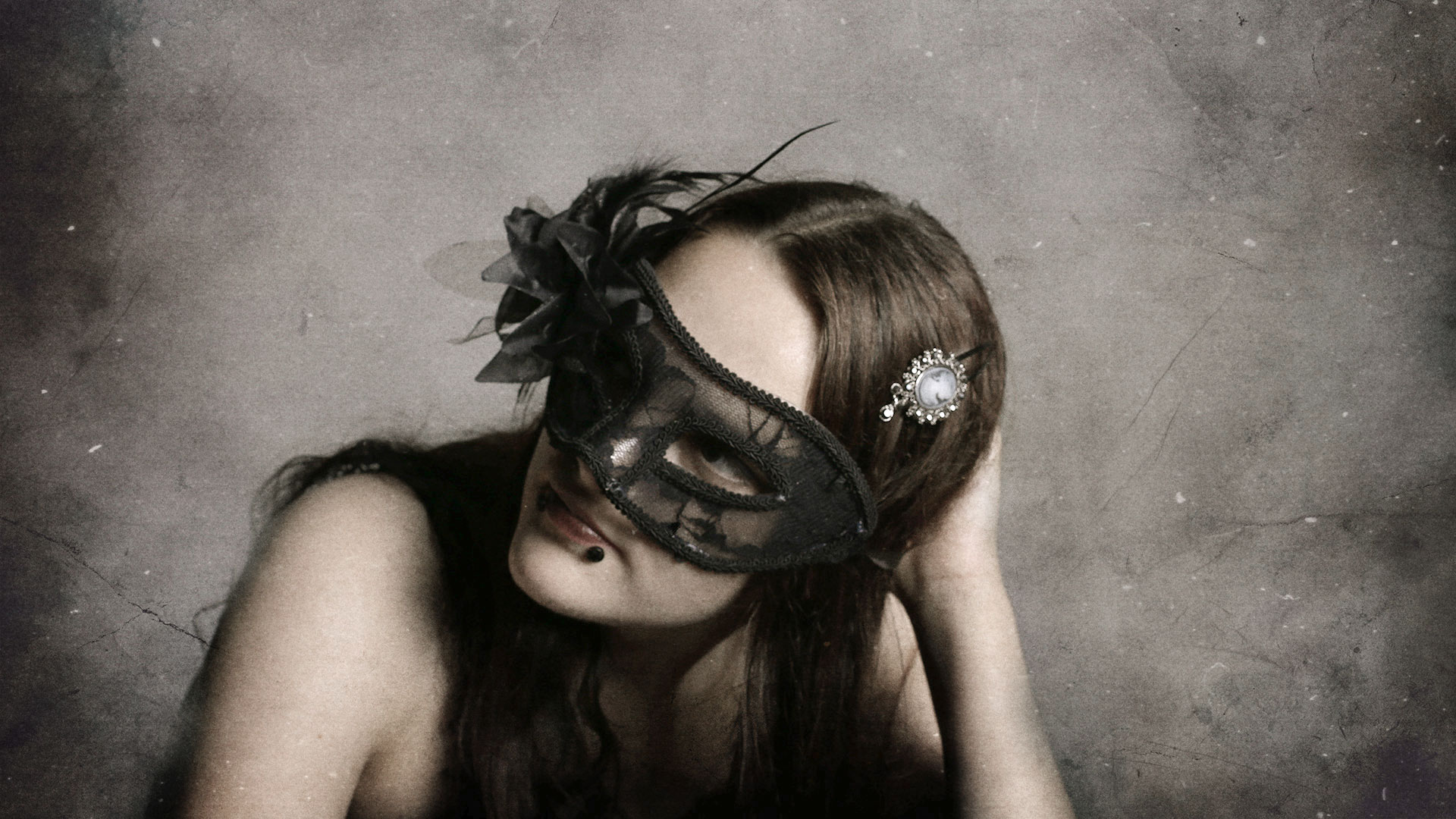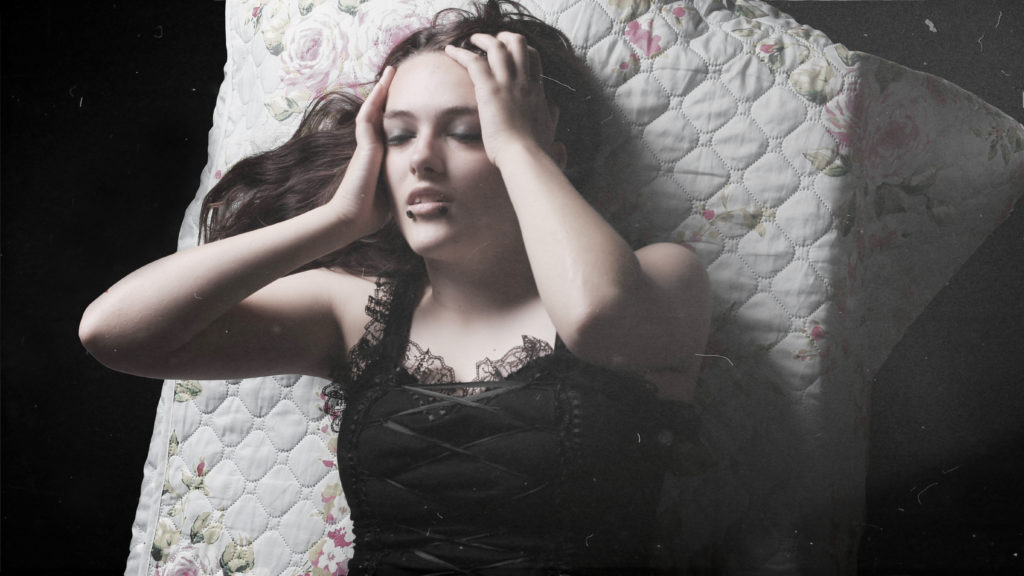DM: Your stirring, tantalising work intertwines surrealist, erotic, neo-noir, and grotesque elements. Talk to us about the creative process behind your dreamlike scenes. How do you generate these fascinating concepts?
A: Creating an image is somehow like being a sleepwalker: you are aware, but it is a kind of scrambled awareness, as if someone else is taking over and leading you.
It begins often with an image or a fragment gleaned from somewhere, which fixes my attention, like an attachment point, without my understanding why. Around that primer, I try to imagine a story, a reason that explains this moment, this snapshot: I am looking for the missing parts of the image. At the same time, I do sketches to set up the composition, to place the geometry inside the frame, to adjust the masses of shadows and light to obtain maximum effect. Visual necessities push me to introduce elements for which I also have to find a narrative role. And each image is also the expression of a purely visual desire, of the desire to create in terms of form, to push the limits of my technical knowledge.

“La lione blessée (Love is a killer)”, for example, started with a complex expression, mixing suffering with ecstasy, read on a woman’s face. I immediately saw, superimposed, the arrows stuck in her flesh. This visual idea, this concept, was born in a second and from there started the drawing process: the question of arranging the image, the lines of force, the movement, the blacks, whites and grays. The search for a balance between density and simplicity. It might sound simplistic, but that’s actually exactly what happens to me in this iterative process between the intuition of a strong but still incomplete mental picture and the material that is building up on the page. Little by little, I approach the moment when I have to put my pen down because it is no longer possible for me to improve the result. This is when I start looking for a definitive double title. Here, it was the memory of a similar impression of pain and strength seen on these famous Assyrian bas-reliefs that gave me half of the answer.




DM: Your ink illustrations are reminiscent of Milo Manara’s artistic depictions of beautiful women in erotic fantasy settings & Moebius’s surrealist & sci-fi illustrations. What are your other influences as an artist?
A: These two are certainly my godfathers of choice … I actually have a very diverse but unfortunately not very deep graphic baggage. On the other hand, it’s great, because since when I have become serious about drawing, I discover every day icons and masters that I might be more able to appreciate now. I have always drawn for my pleasure, as an autodidact and without pretensions and it was rather literature that interested me as a way of expressing myself. Whether it was “Madame Bovary” by Flaubert or “I am Legend” by Richard Matheson, what fascinates me is this power of the writer to arouse with words, like a medium that exudes ectoplasm, a complete world, an absolutely believable alternate reality. Which is, in retrospect, rather surprising because I somehow specialized in singular and laconic illustrations and I am still a long way to creating a graphic novel…
DM: Are your horror-themed illustrations inspired by nightmares, horror films, or literary fiction?
A: Literature plays a big role in the development of my drawings. However, I rarely work with the aim of illustrating a text; it is rather the opposite that happens: I start to work on a drawing without knowing yet where it is going to take me and as it gains shape, I realize that it echoes some reading that struck me.
I am not really interested in horror for its frightening potential, but more for the feeling of strangeness it sometimes produces. This feeling to be beside yourself, on the verge of entering a parallel universe. I had a revelation when I read a collection of short stories by H.P.Lovercraft which exists only in French under the title “Démons et merveilles” and gathers the wanderings of Randolf Carter. This title, which roughly means “Demons and Wonders”, perfectly sums up this state of mind that I’m trying to create, where one is both afraid and attracted, repulsed and fascinated. When you feel something is off but somehow enticing – and you suddenly realize you are off and on the way to a deeper meaning.




DM: What kind of response do you expect your viewers to have whilst appreciating your art? Your Instagram bio states “I draw for my own sake and for your pleasure.” Considering many of your drawings are sexually explicit, do you believe they have the effect of inducing this type of stimulation? Since there are peculiar elements within the scenes depicted in your erotic drawings as well, do you think we have become desensitised to more conventional types of visual stimulation?
A: I’m sure it has an exciting effect, because my drawings stimulate the greatest erogenous zone there is: the brain. But this is not the effect that I am primarily looking for; it is at most a secondary phenomenon. I would like to believe that my drawings are visual puzzles which, like double-bottomed drawers, encourage us to seek beyond the jubilation of fluids, to question, to look at ourselves, to be both voyeur and seer. Then: if I am talking about pleasure, it is not specifically physical pleasure that I mean, but rather aesthetic pleasure, which is the sum of body, senses, emotions, mind and soul. And this pleasure is boundless.
DM: There are some fetishistic elements in your work that can be considered transgressive, as they challenge the boundaries of what is acceptable in some people’s view. Despite that, there are many people who appreciate your artwork. This could be a great sign that people are becoming less repressed, more in touch with their “shadow selves” or comfortable enough to appreciate art that tackles taboo subjects. What are your thoughts about this?
A: I am sure that young people are less repressed than their elders, but from a legal point of view, these are the ones leading the dance. Then I honestly think it’s getting easier and easier to be transgressive today, as very strong conservative currents are reestablishing stricter standards … But, to answer the question, I don’t have any sound explanation why my art found a very large audience; I am the first to be surprised. I can only make assumptions. Maybe the aestheticization of sexuality makes its access less suspect, because somehow we are conditioned to think that what is beautiful is also good. The fact that many of the drawings also have a touch of humour and that they appeal to the intellect probably helps to uninhibit a certain audience, who otherwise would stay off graphic content – at least overtly.



DM: There is something subversive and ironic about your work, especially when viewed alongside some of your titles and captions, and it has been viewed as a rebellion of the female gaze. When I look at your artwork overall, I don’t feel like it goes against the cinematic concept of the “male gaze”; instead, there is an ambiguity that means it can appeal to both female and male viewers in different ways. In fact, it probably appeals to each individual in a unique way, as viewers project their own thoughts and fantasies onto them. Do you agree?
A: Absolutely. It is indeed ironic that I use black and white so much, and that I seek ambiguity in each of my drawings. I try to create images that are anything but one-dimensional and nothing irritates me more than criticism when it stops at the superficiality of the first possible interpretation. I believe, moreover, that it is the stigma of fanaticism to be incapable of seeing anything other than the narration of which one is already convinced.
It is true that the male gaze is a very powerful cultural formatting, and the female gaze is an attempt to escape it, to make room for other narratives. But I don’t believe that one should replace the other; rather, I think it’s a chance to create something new, as the rediscovery of perspective has allowed painting to be reinvented, and to rediscover the world beyond time and horizon. The highlighting of the feminine gaze is certainly a deserved reparation in view of the banishment of women from any leading role for centuries, but it is for me, at the creative level, above all an incentive to look beyond gender, and to create works that reflect not the categories but rather the fluidity of identities and their projections in sexuality.
Personally, I find it hard to imagine an art that is not inclusive, that does not try to offer a gateway to multiple users. A work of art should allow us to see differently, beyond our biases – to see how the other sees and through that, to see yourself differently.
DM: What do your fans and followers confess to you? What is the most interesting or surprising comment you have received relating to your work?
A: I will not betray the confidence of my fans by reporting here what they tell me in private … but what always surprises me is the strength of identification they feel towards images that all in all come from the privacy of my mind. These images become theirs, are real parts of their biography, past or future. Often times they even tell me, “That woman, that man you drew is me, one hundred percent!”
DM: Let’s delve into your mind for a little bit. Is there any visceral experience or dream you’ve had, that significantly impacted your path as an artist?
A: That one is difficult, because there is no direct path between a specific experience and my work as an artist. But I can relate an experience, which has happened to me many times in different forms and which has convinced me very early that the texture of reality is in large part a projection of the mind. When I was a child, I found myself, without an adult, on a small boat in the middle of a very violent storm. The situation was dangerous because I was in the middle of reefs and the wind and the waves could take control of my skiff. While I was struggling to get away from the coast and I was surveying the bottom to identify obstacles, I saw, as clearly as I can see this page, instead of the boulders that should have been there, the collapsed ruins of a Cyclopean city. Needless to say, I returned to the site after the storm and only discovered a very common seabed…
DM: Do you remember your first drawing?
A: Yes, but it was more than a drawing, it was quite a collection: the codex by Leonardo da Vinci. I discovered a perfect fusion of pure science fiction and formal perfection, summoning everything from geometry to weaponry, from anatomy to architecture with an unbelievably clear but also mysterious style.
DM: I know you are a private person and you like to remain anonymous, but are there any autobiographical elements in your work, in some sense? I’m thinking, of course, in a symbolic, disguised way, or in the sense that it depicts your own fantasies. But I will leave this question open to other interpretations!
A: The answer would be yes, my drawings do feed off my substance, but how is indeed private. And to be honest I find that irrelevant and boring because the only reality that matters is the one my drawings create, and not the one I live in. I might be this magical individual who lives crazy adventures, but I have after all, to walk eventually through a banal little door and go back to everyday life, take the metro, etc …
DM: What are some other forms of art you appreciate?
A: Movies, music, literature, sculpture, architecture, videogames… I am omnivorous; a lot of things speak to me. Some because they excite my narrative fantasy, others for their formal aspect. What I like above all is the immersive side of a work, its ability to touch me at all levels, simultaneously: that it triggers my hormones secretion as well as my spinal fluid.
DM: What can you tell us about your new volume of drawings, Chapter 4 of ‘Ink is my blood’? Have your sources of inspiration shifted since your last volume?
A: Volume Four collects most of my graphic work created between 2017 & 2018. It is pure Ink is my Blood – only more so… These drawings bring us closer to today and their technical intensity is added to the themes that are dear to me. It contains among other things one of my favorite images “La technicienne de surface (Worshiping my Idol)” which concentrates everything I love in a drawing: eroticism, irony, phantasmagoria, social criticism, religious iconography, etc … It is completed with an erotic short story by Jehnny Beth, best known as the lead singer in the Anglo-Saxon band Savages and as solo singer with her new album ‘To Love Is To Live’.
